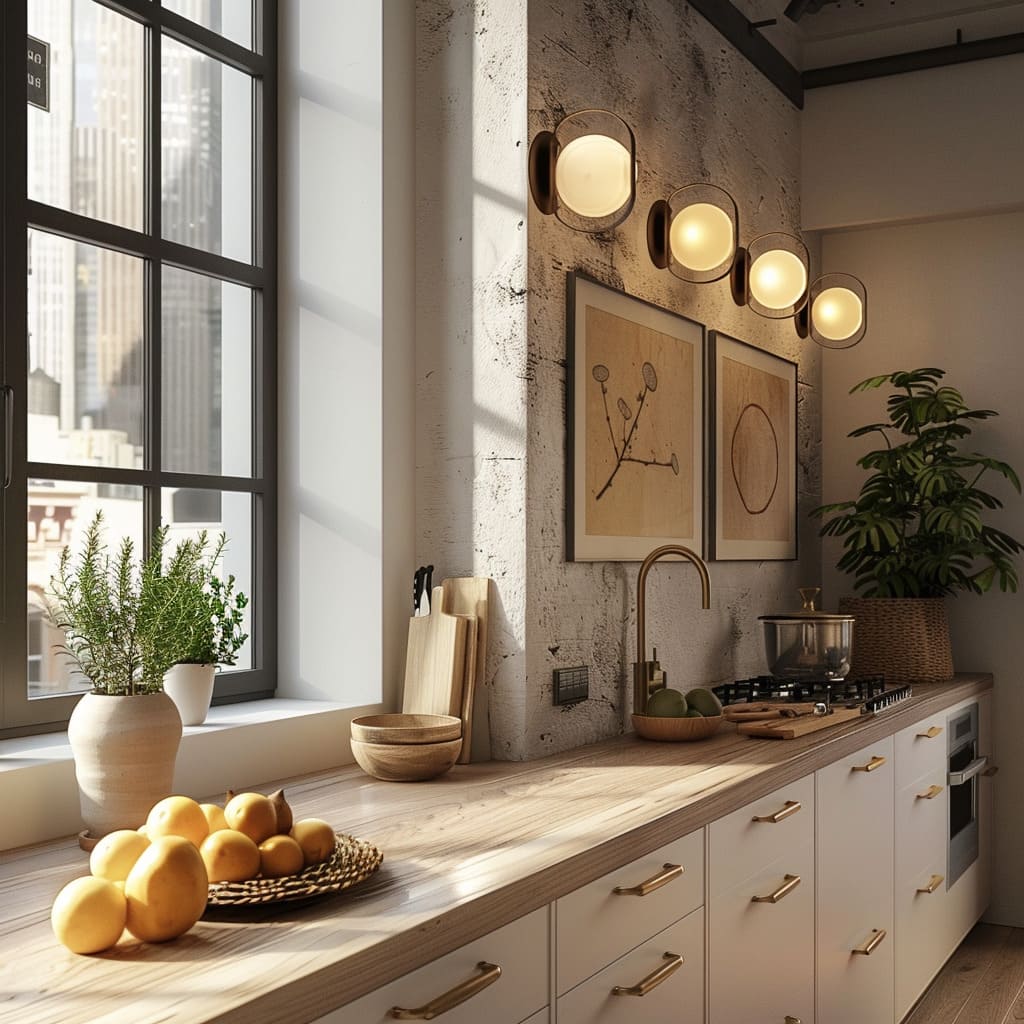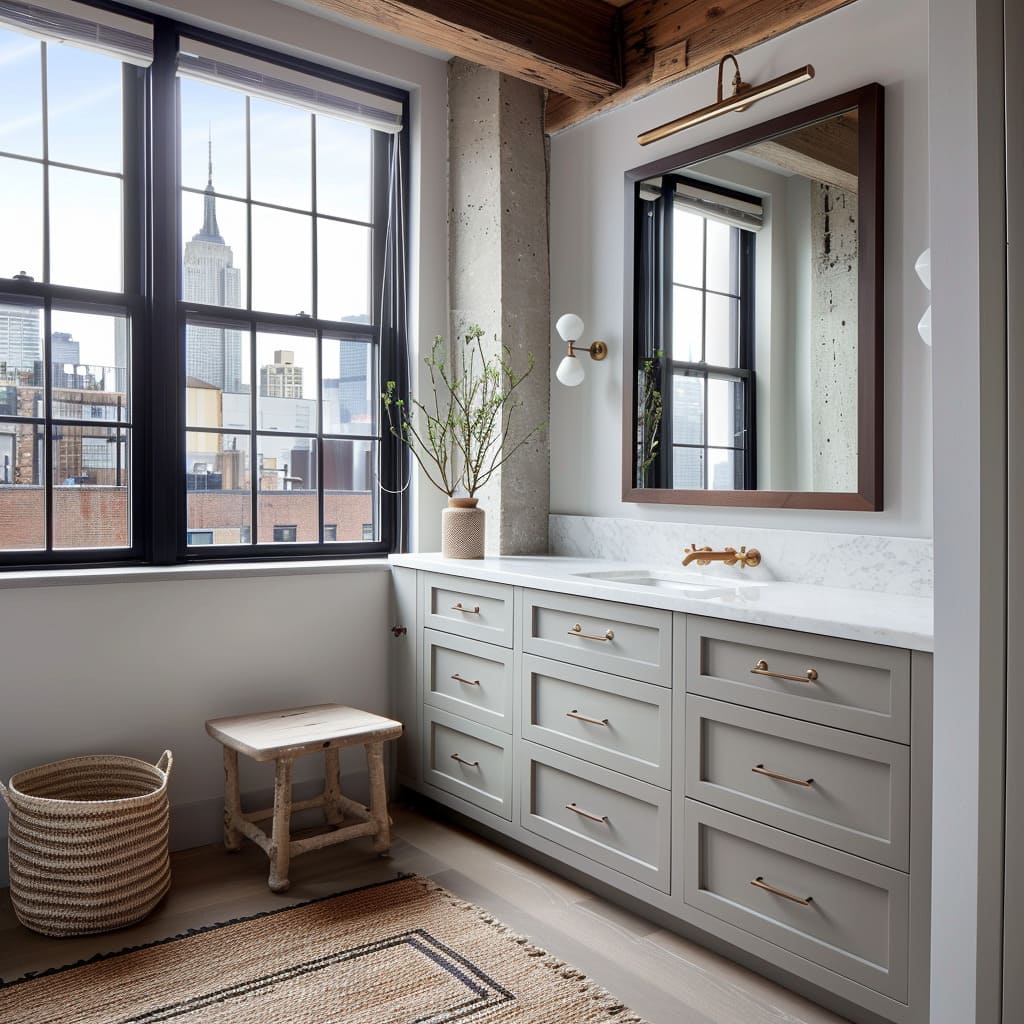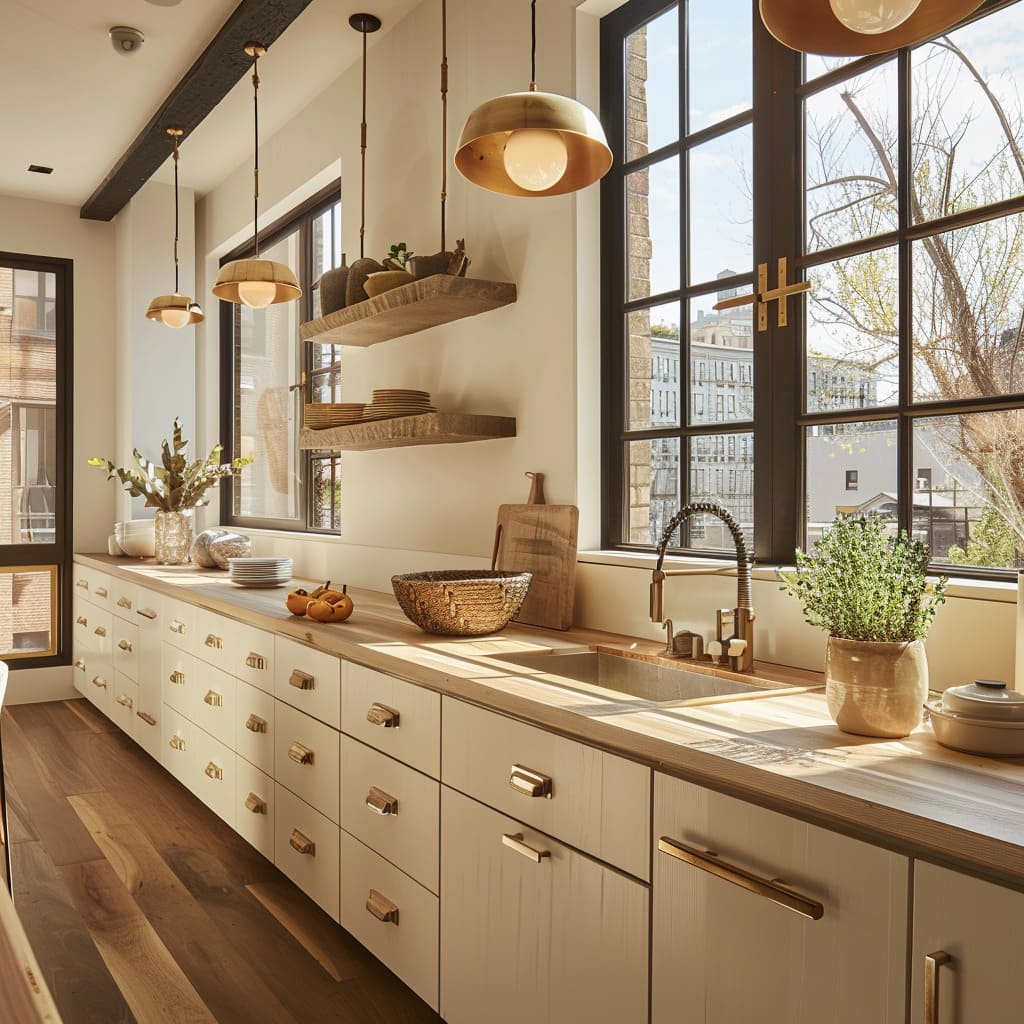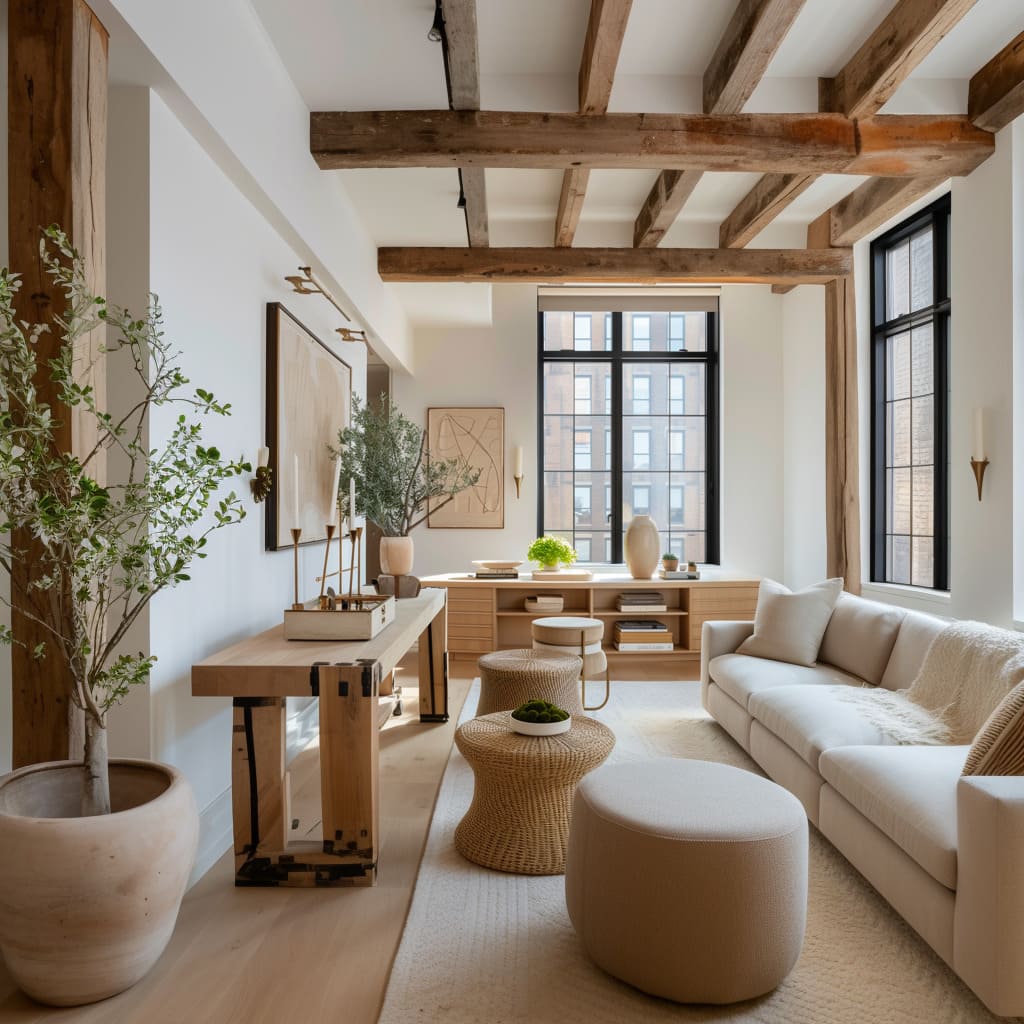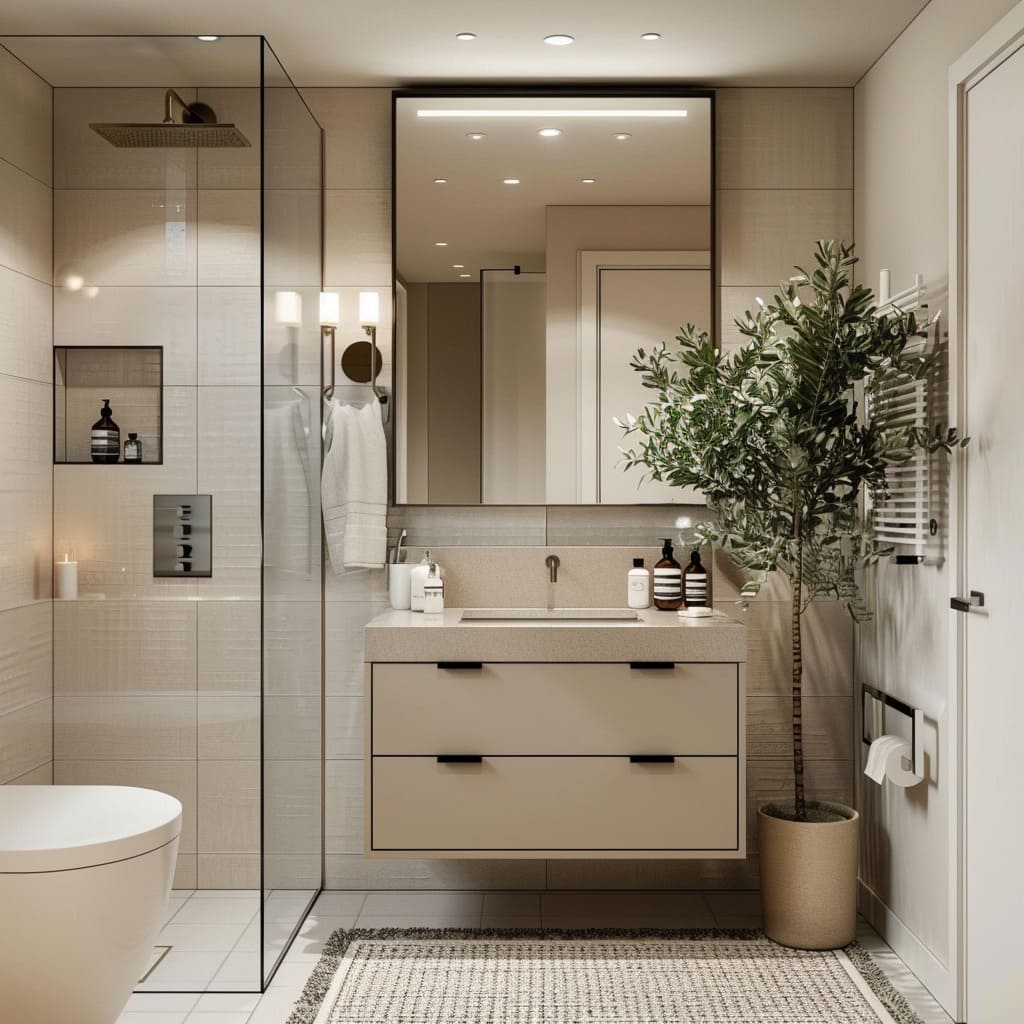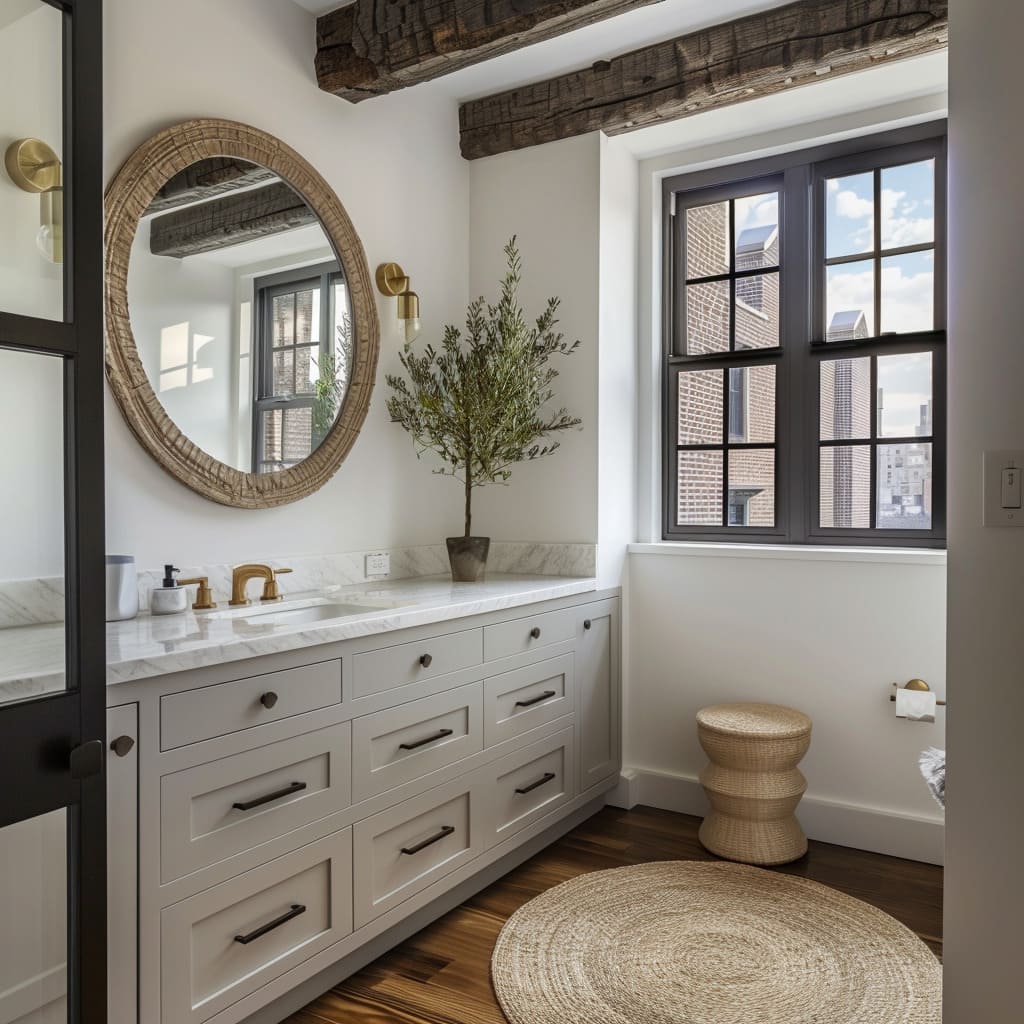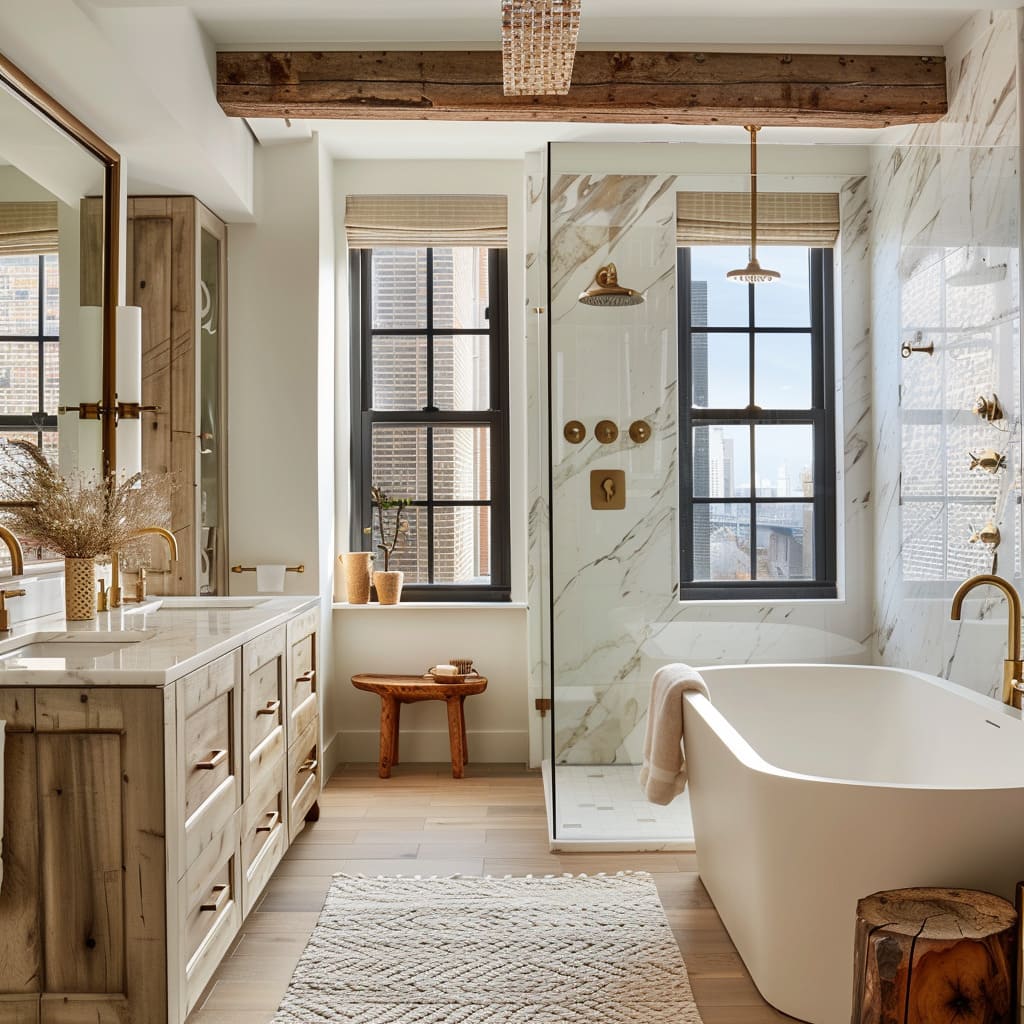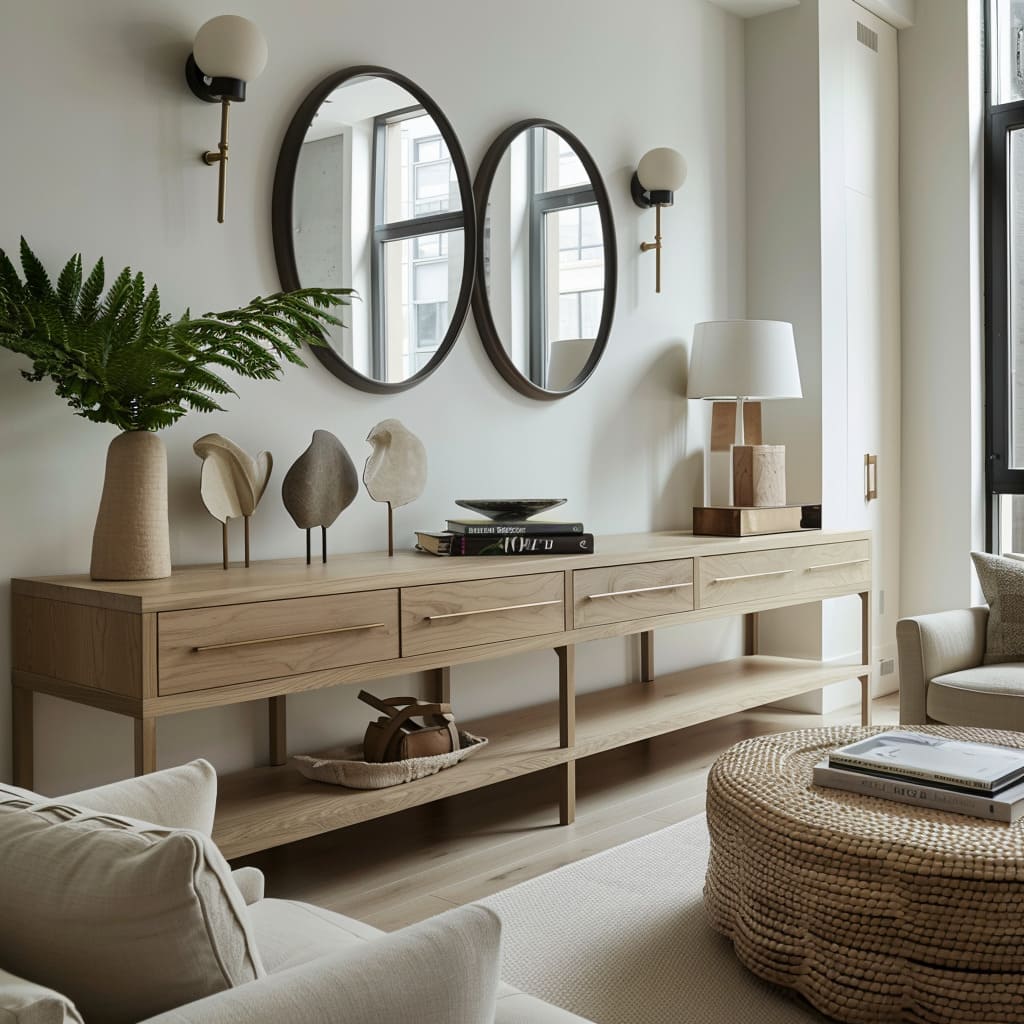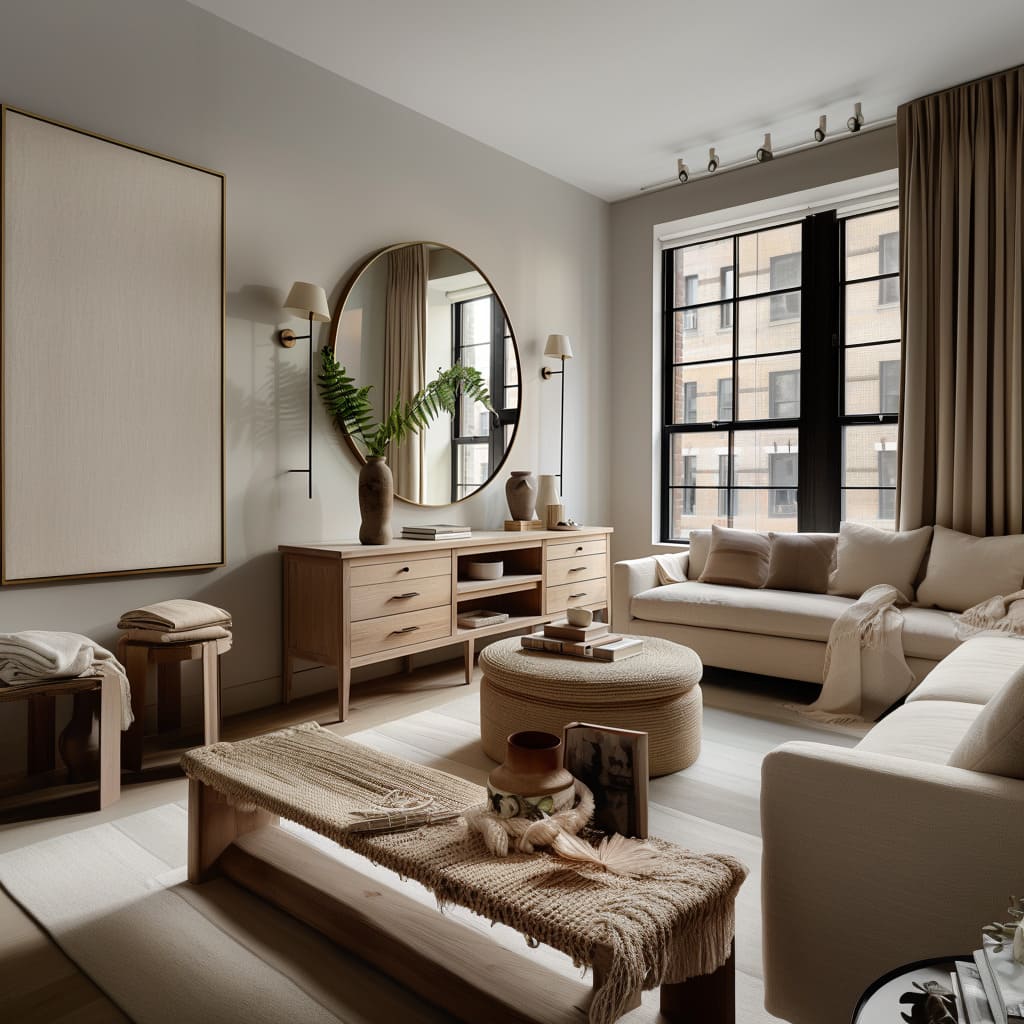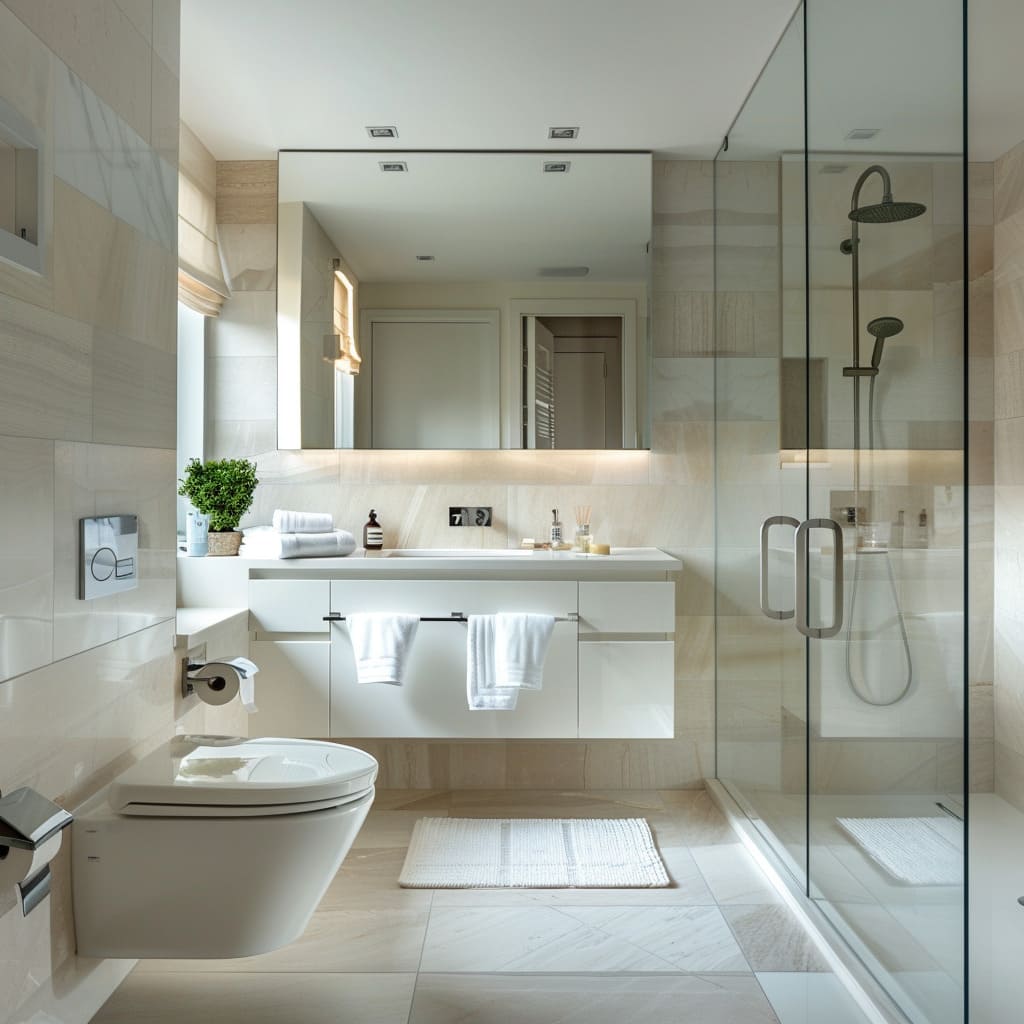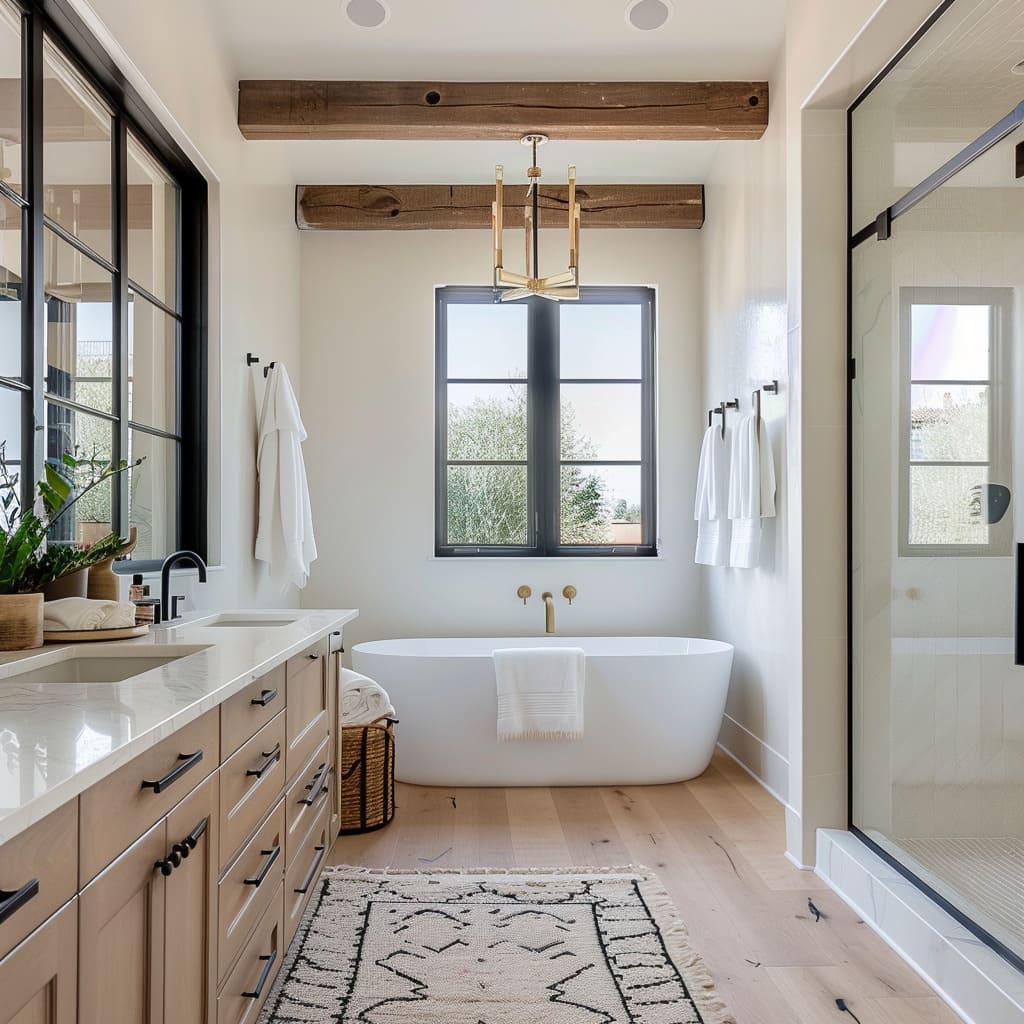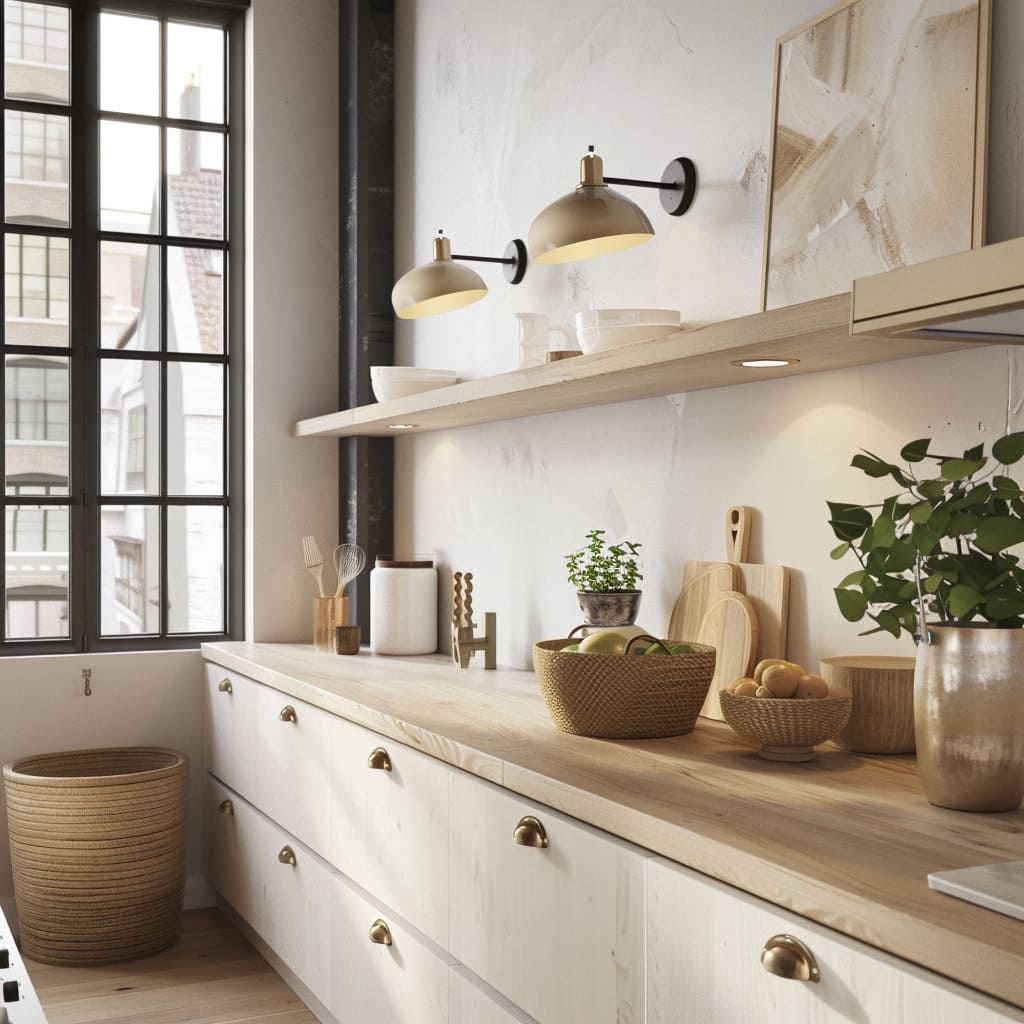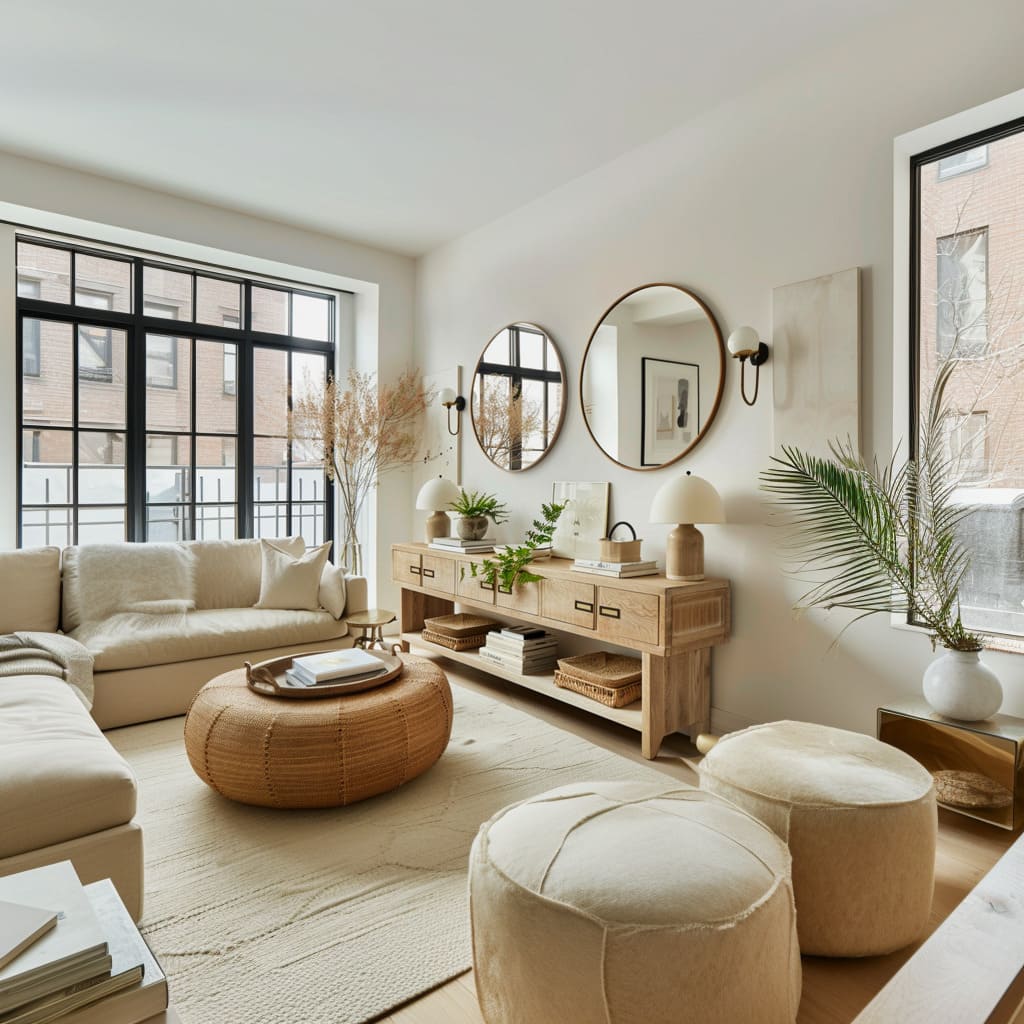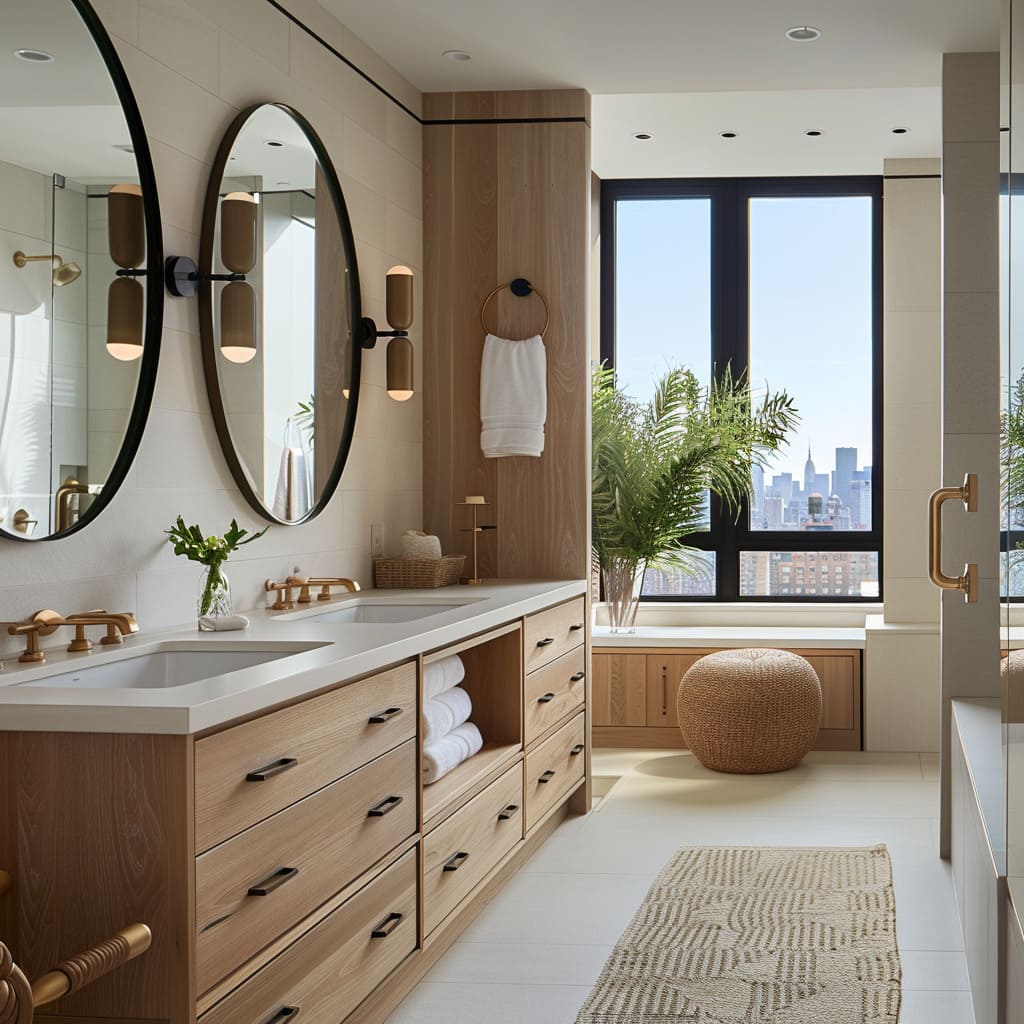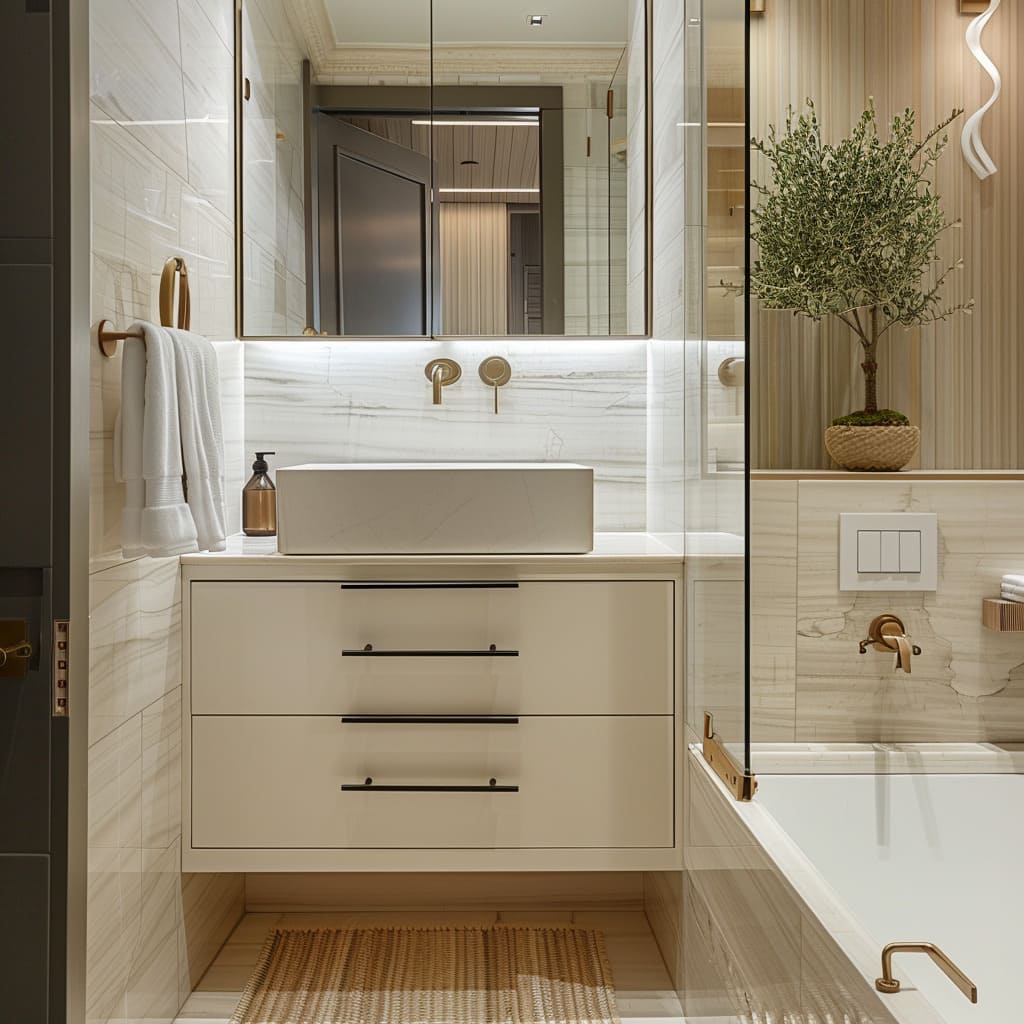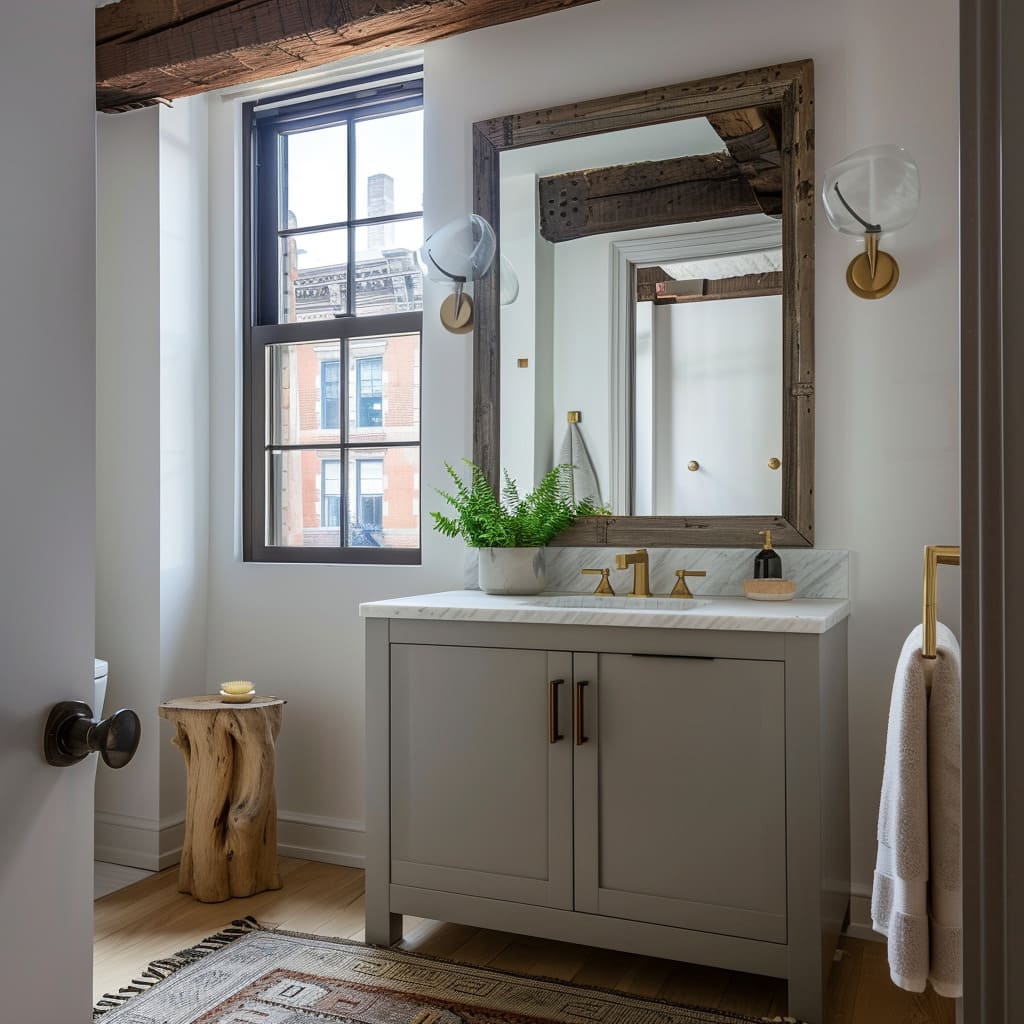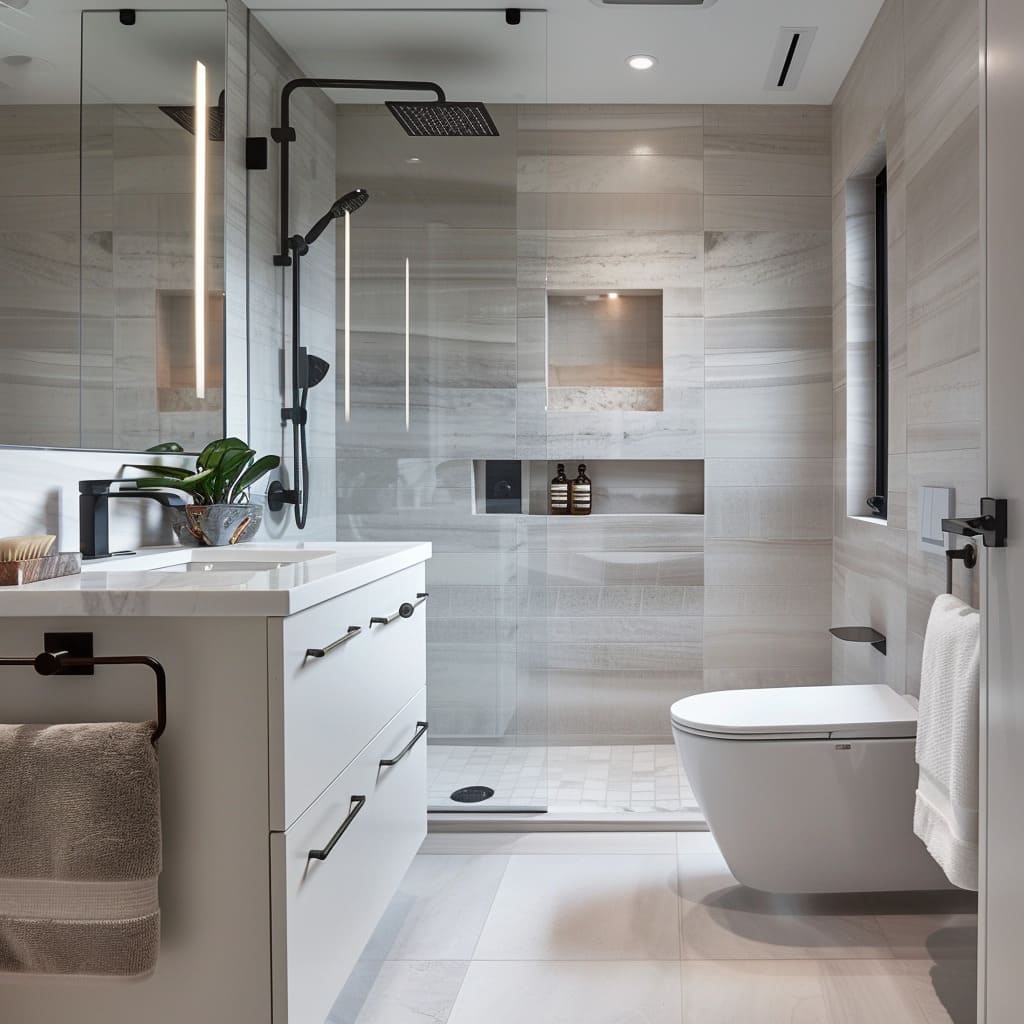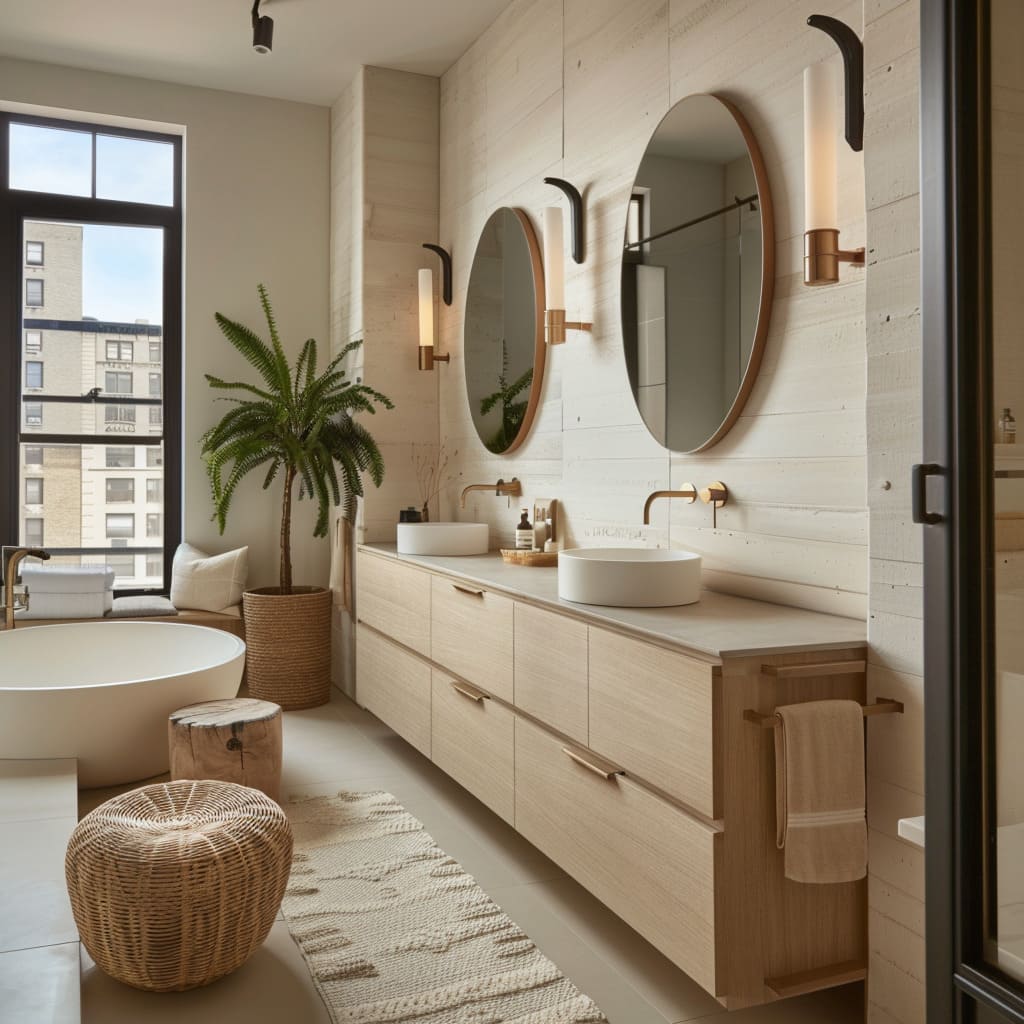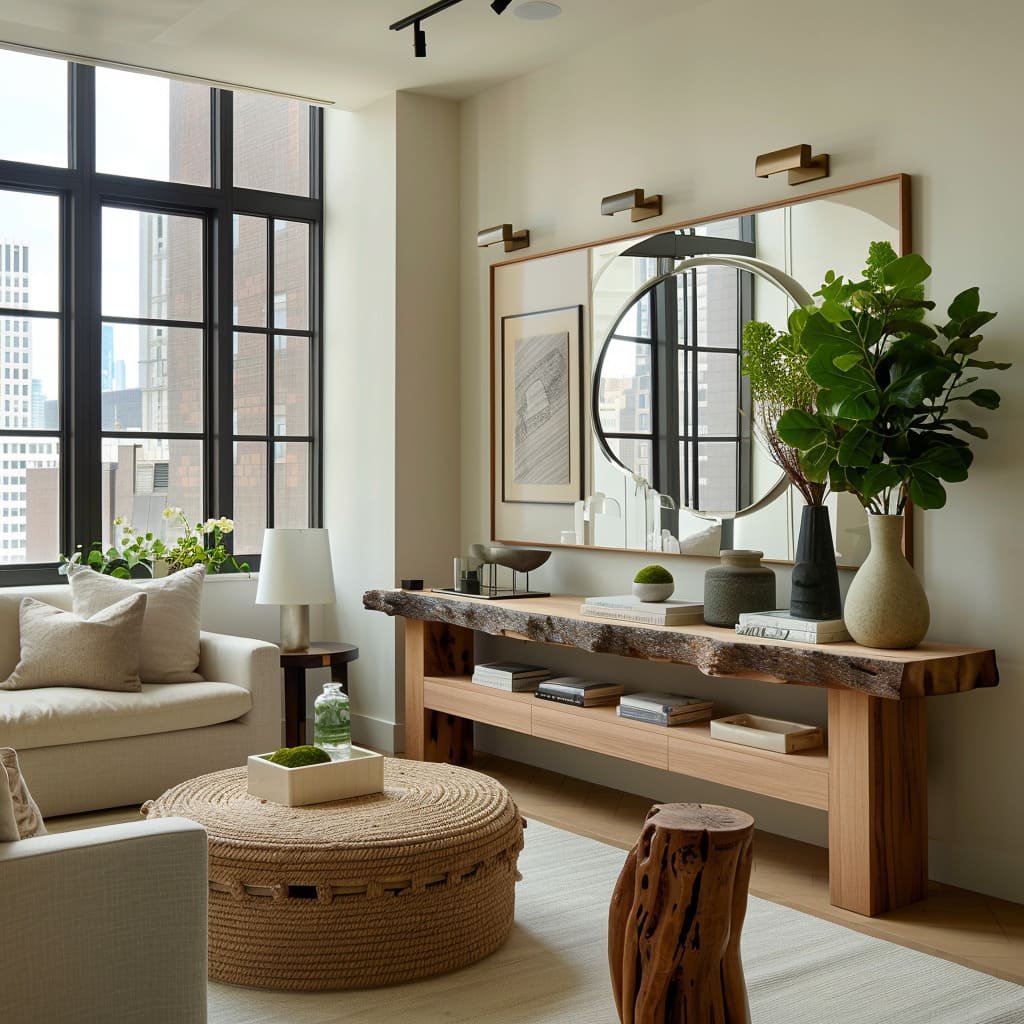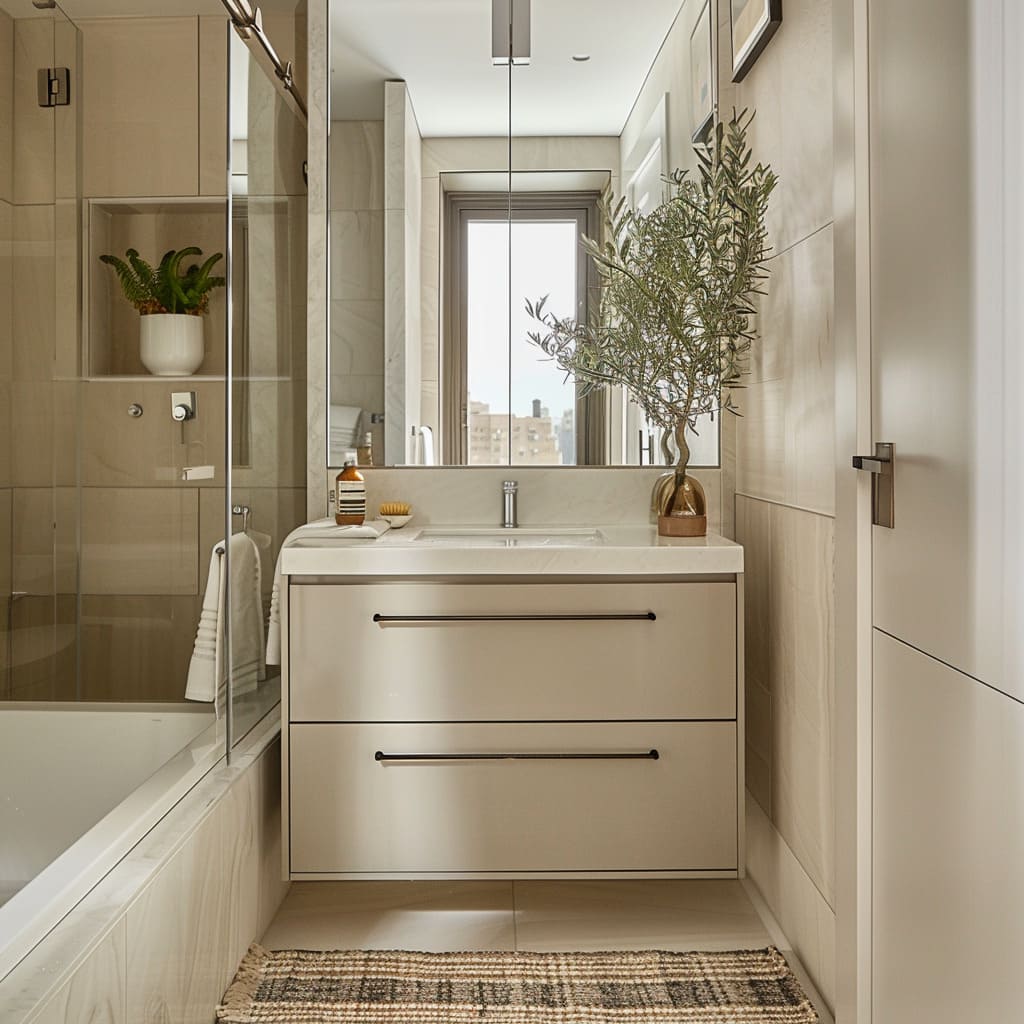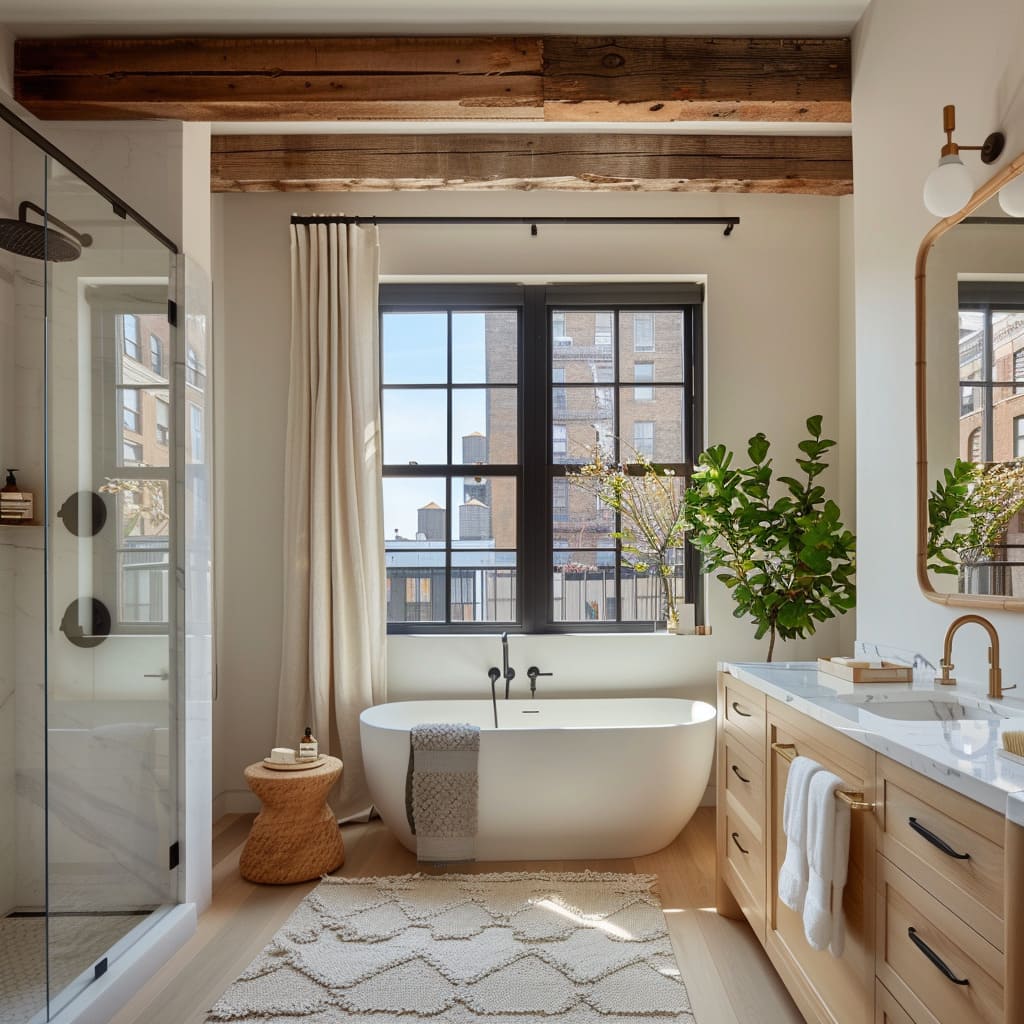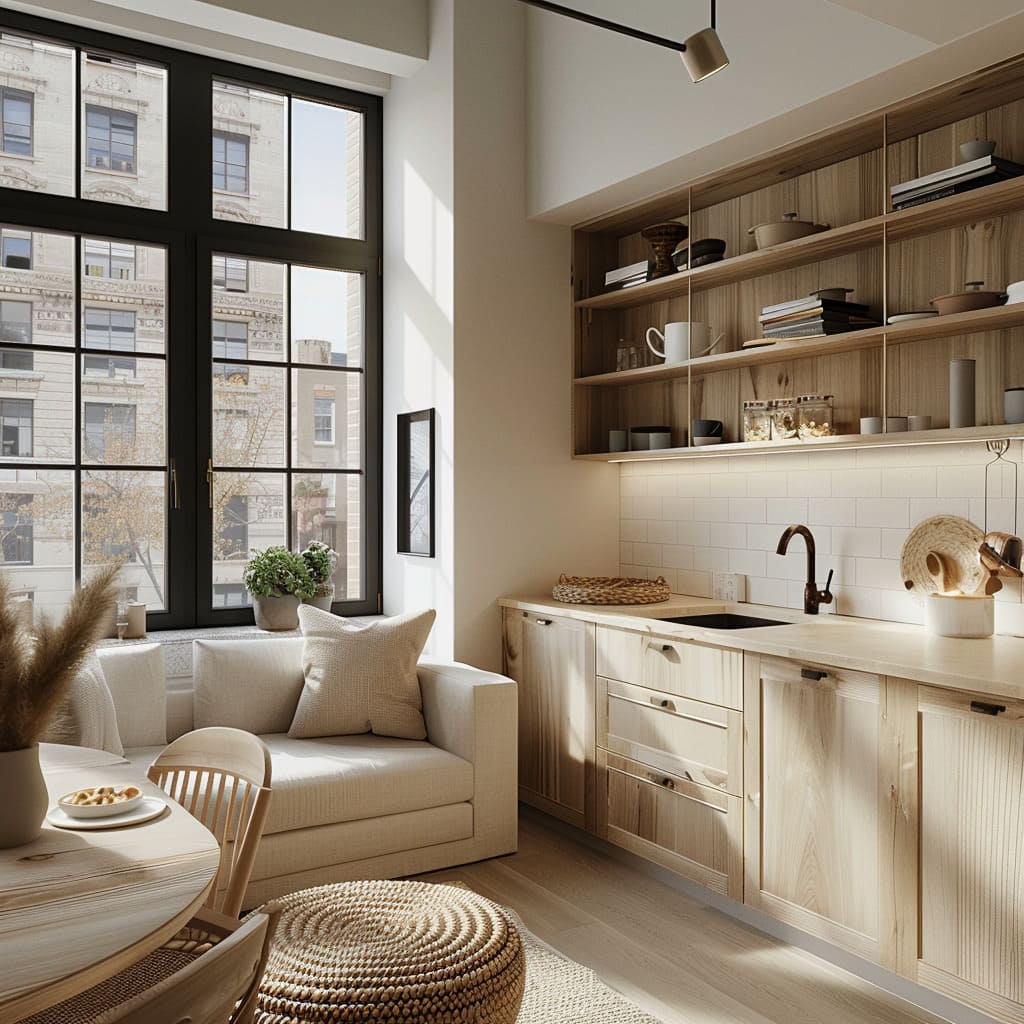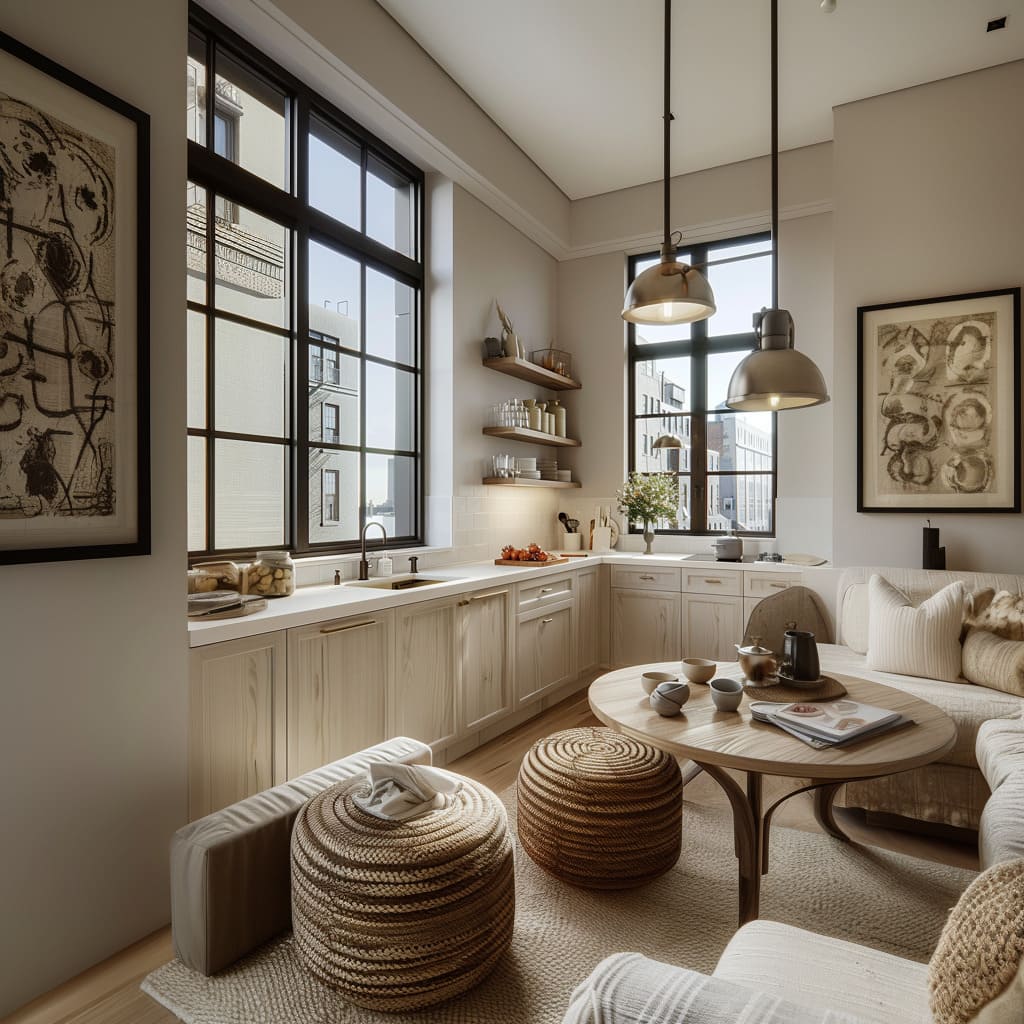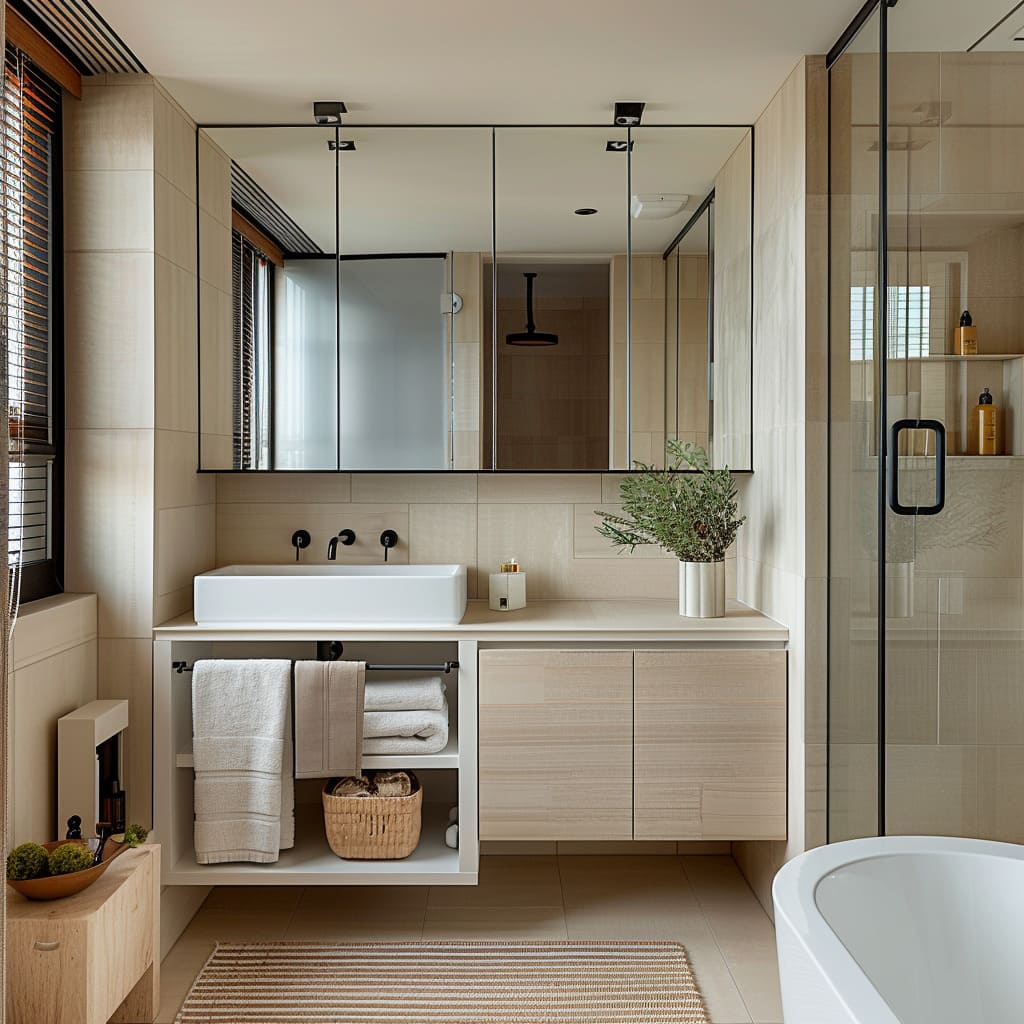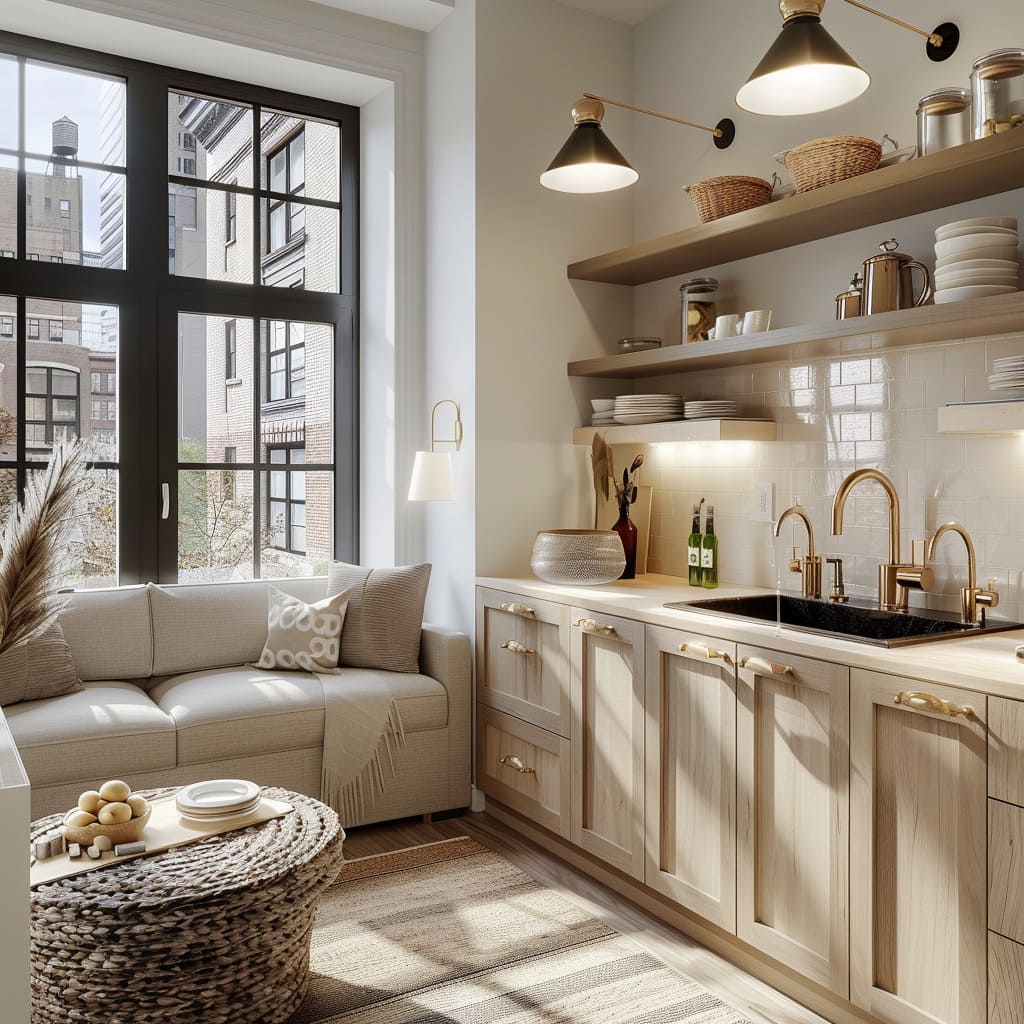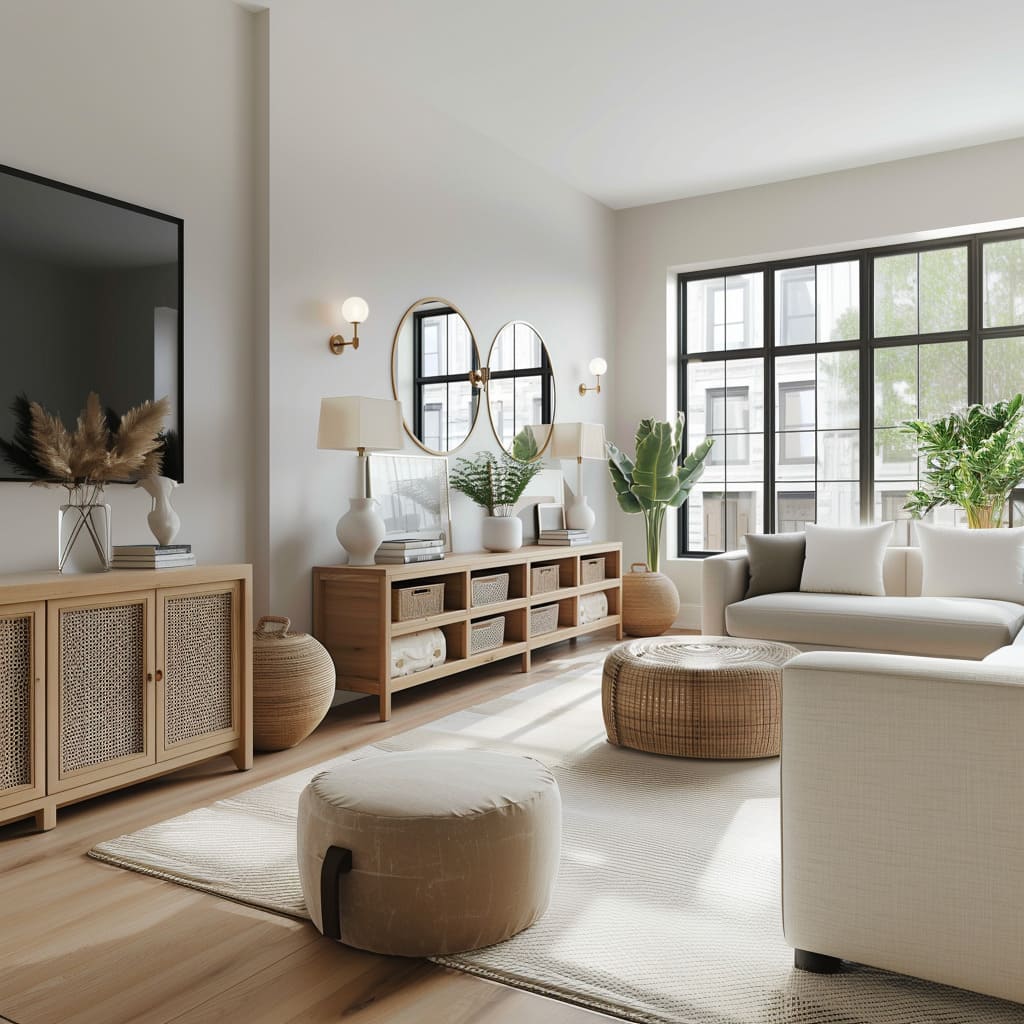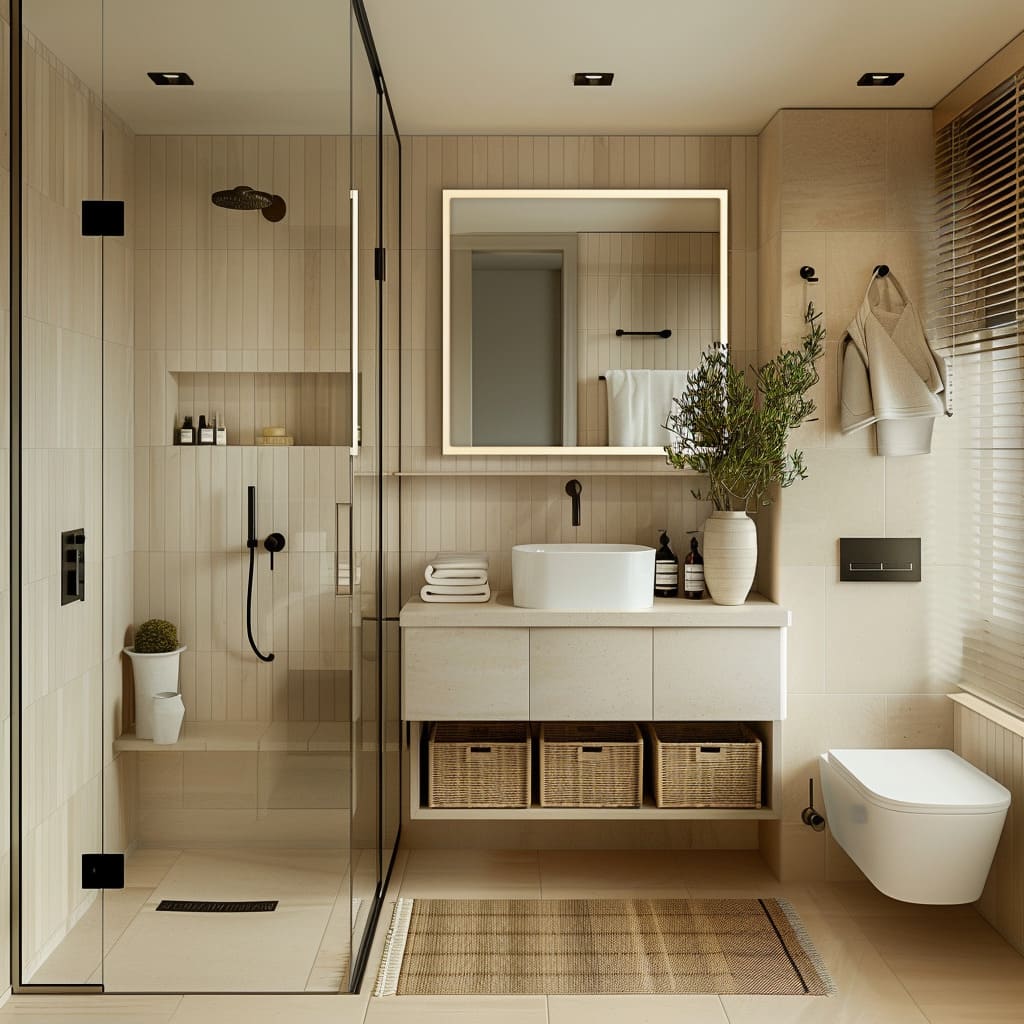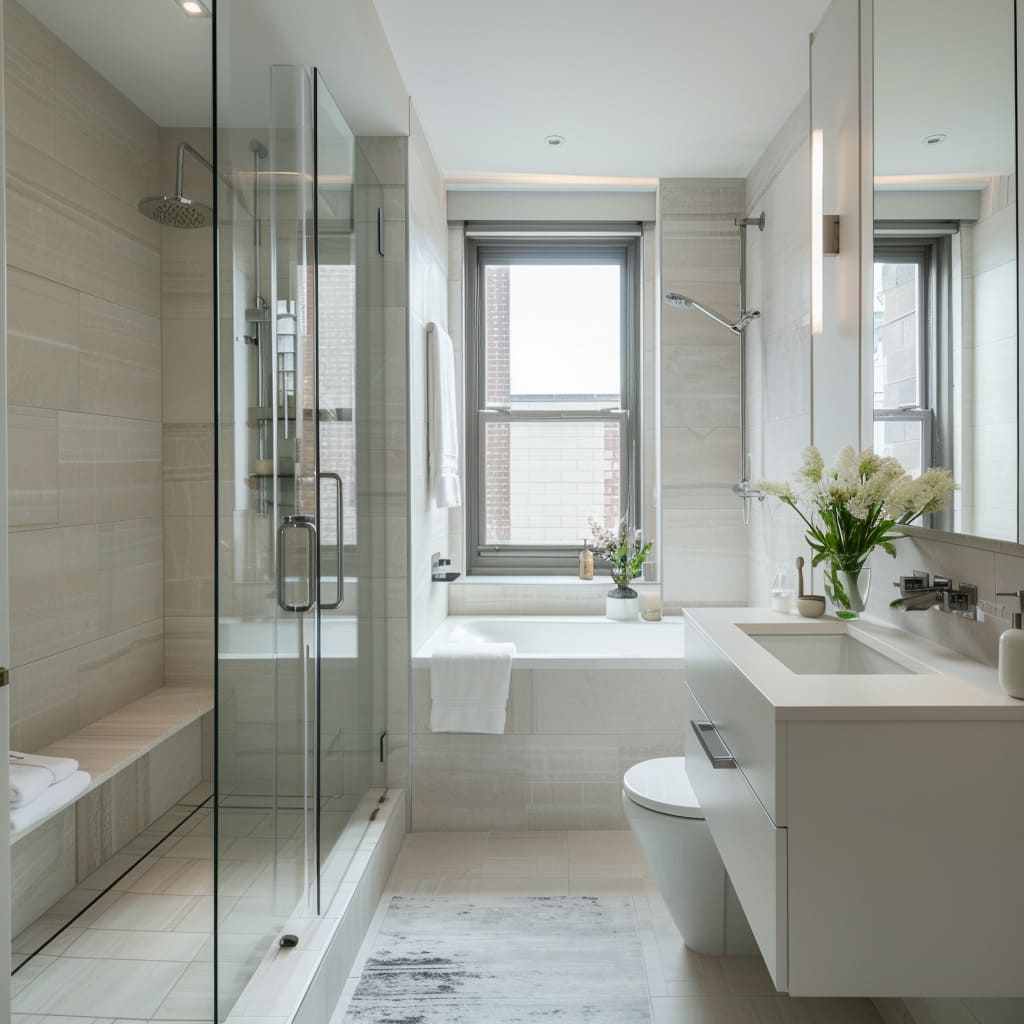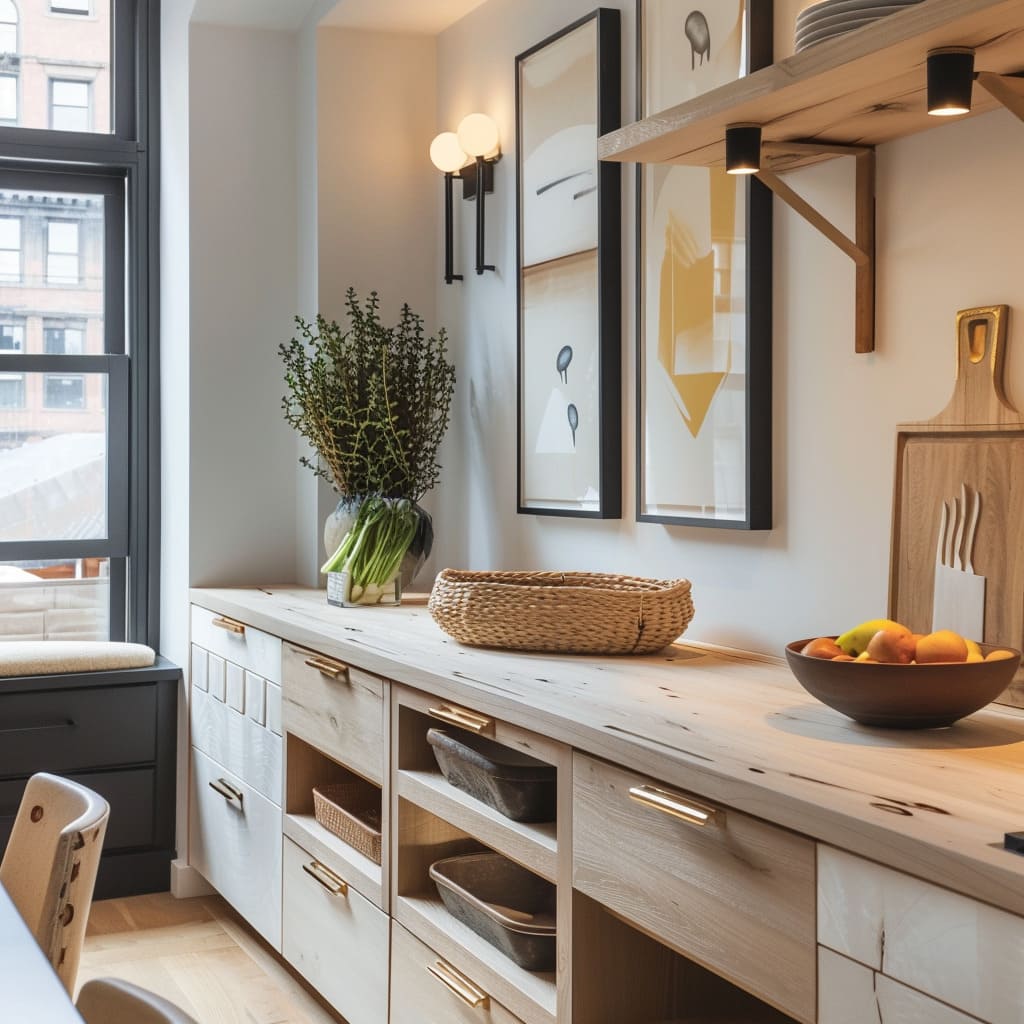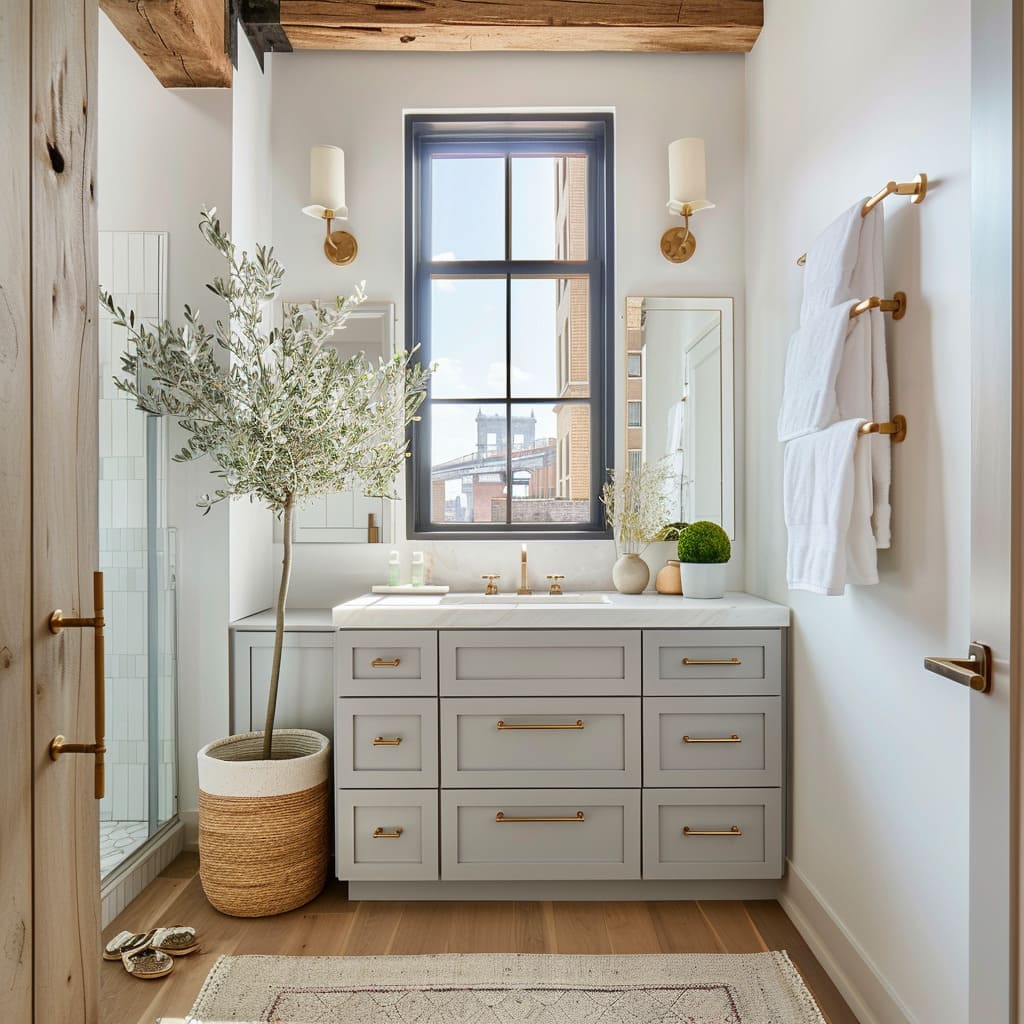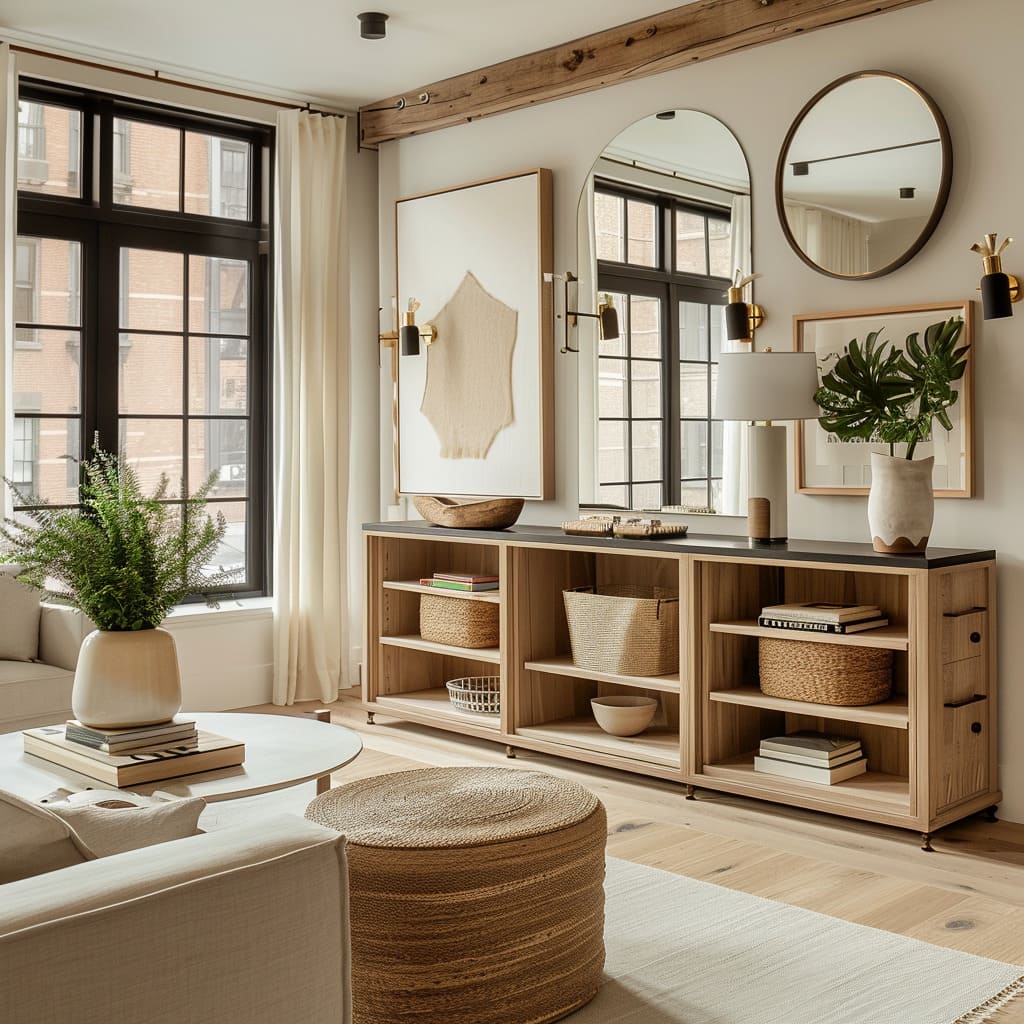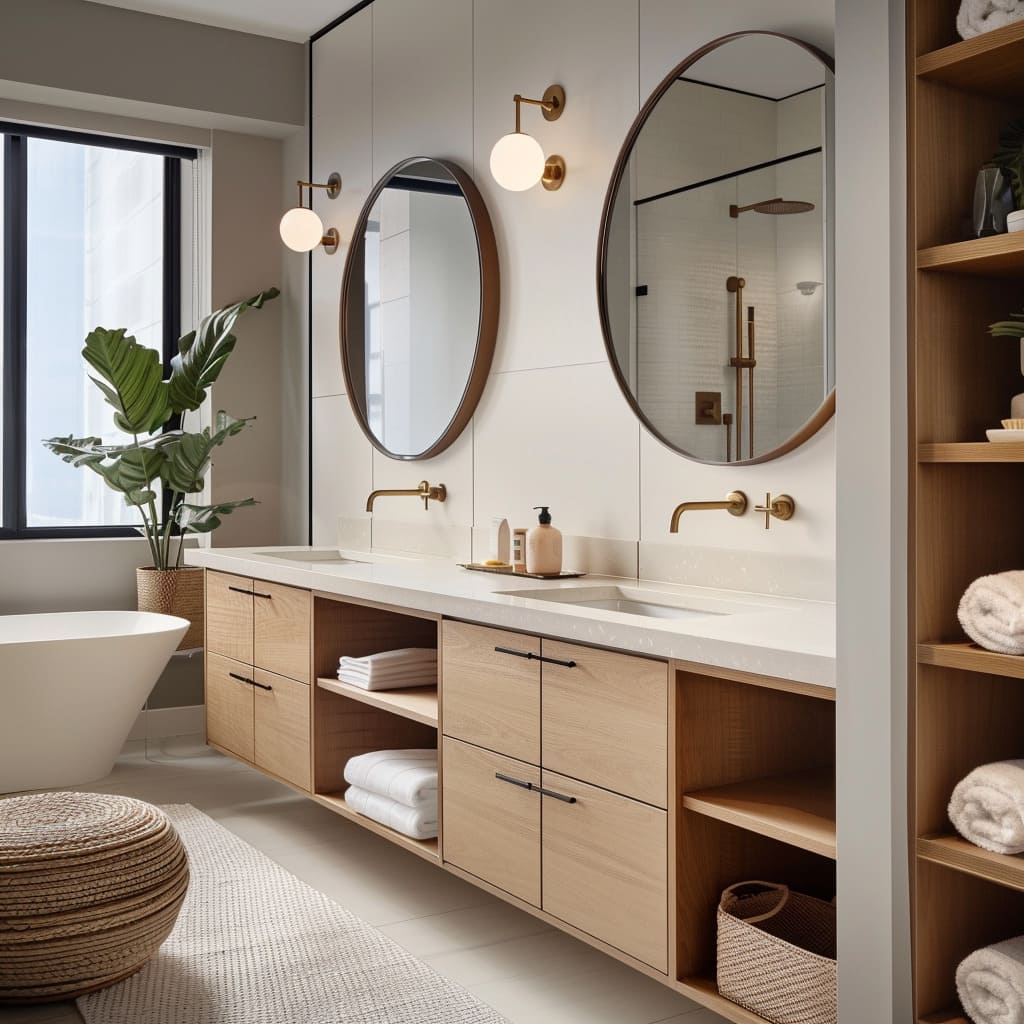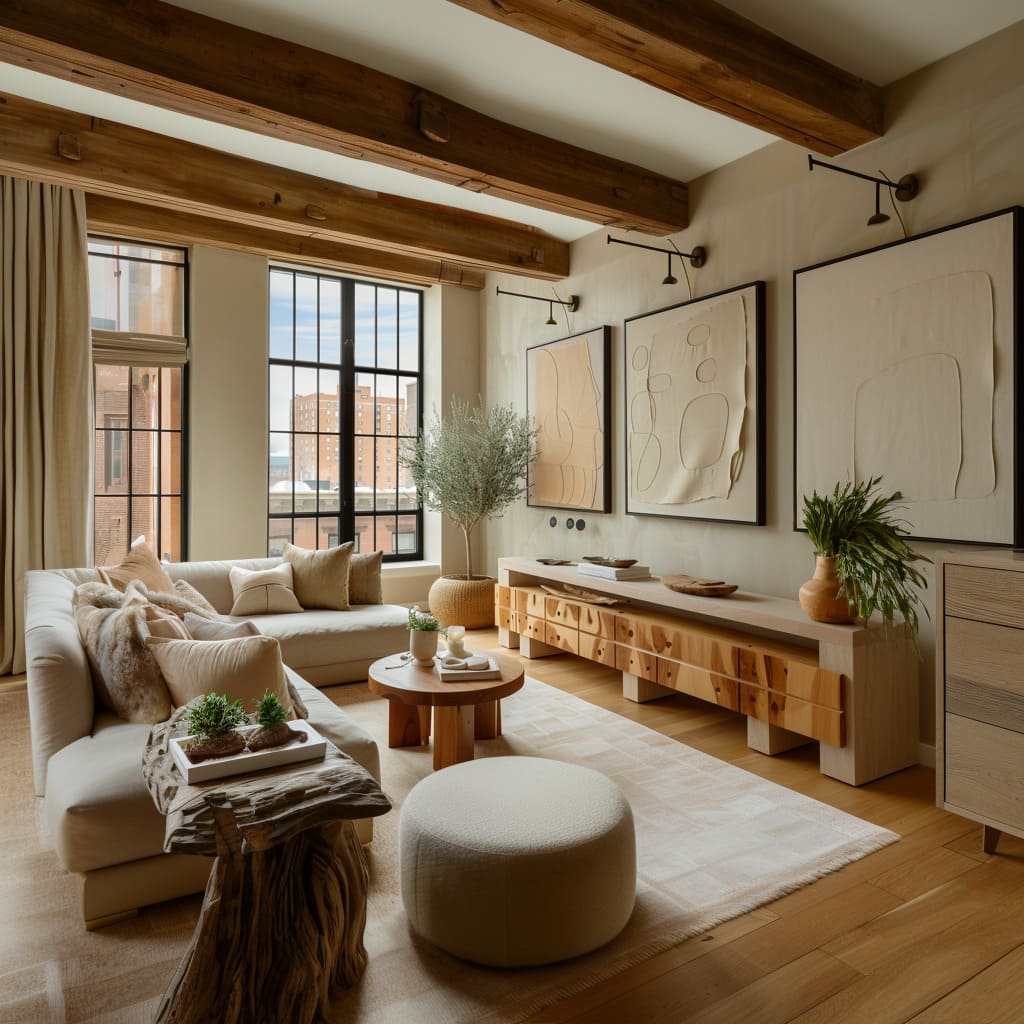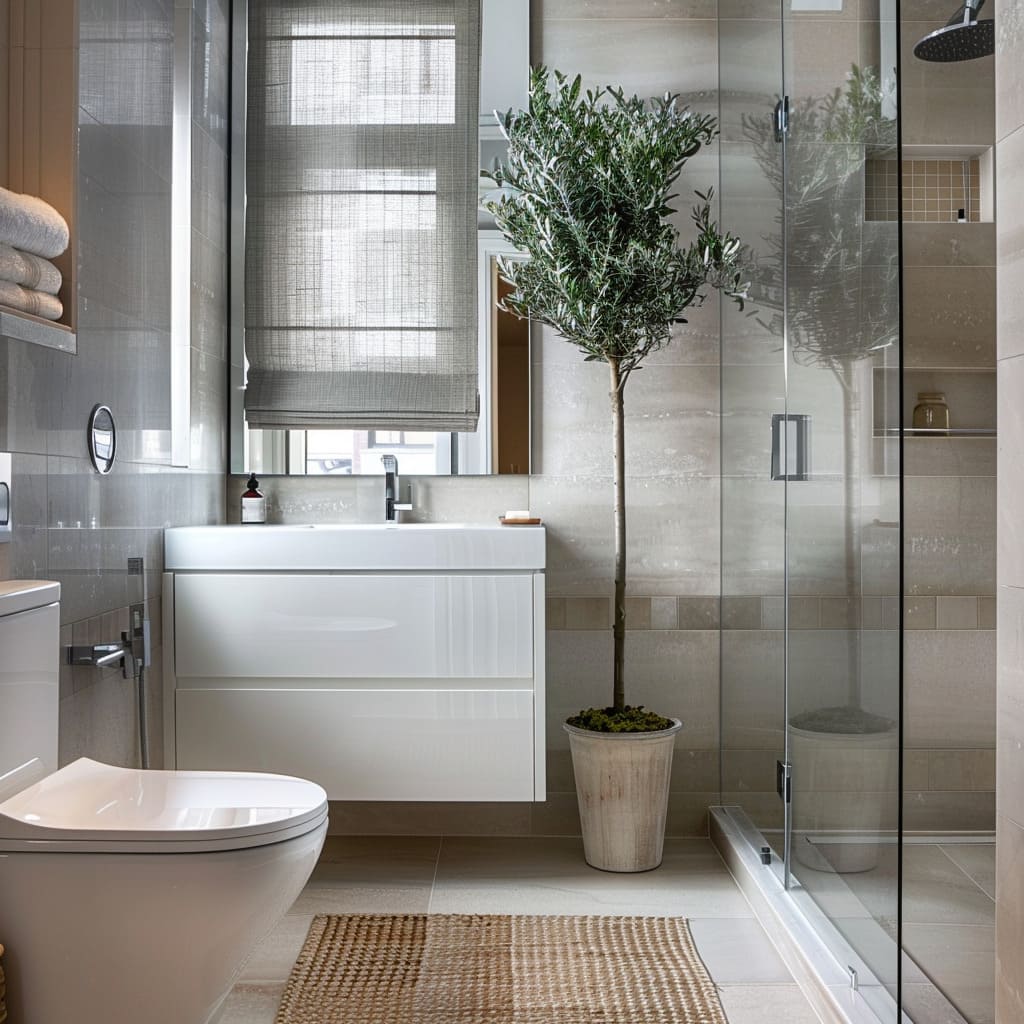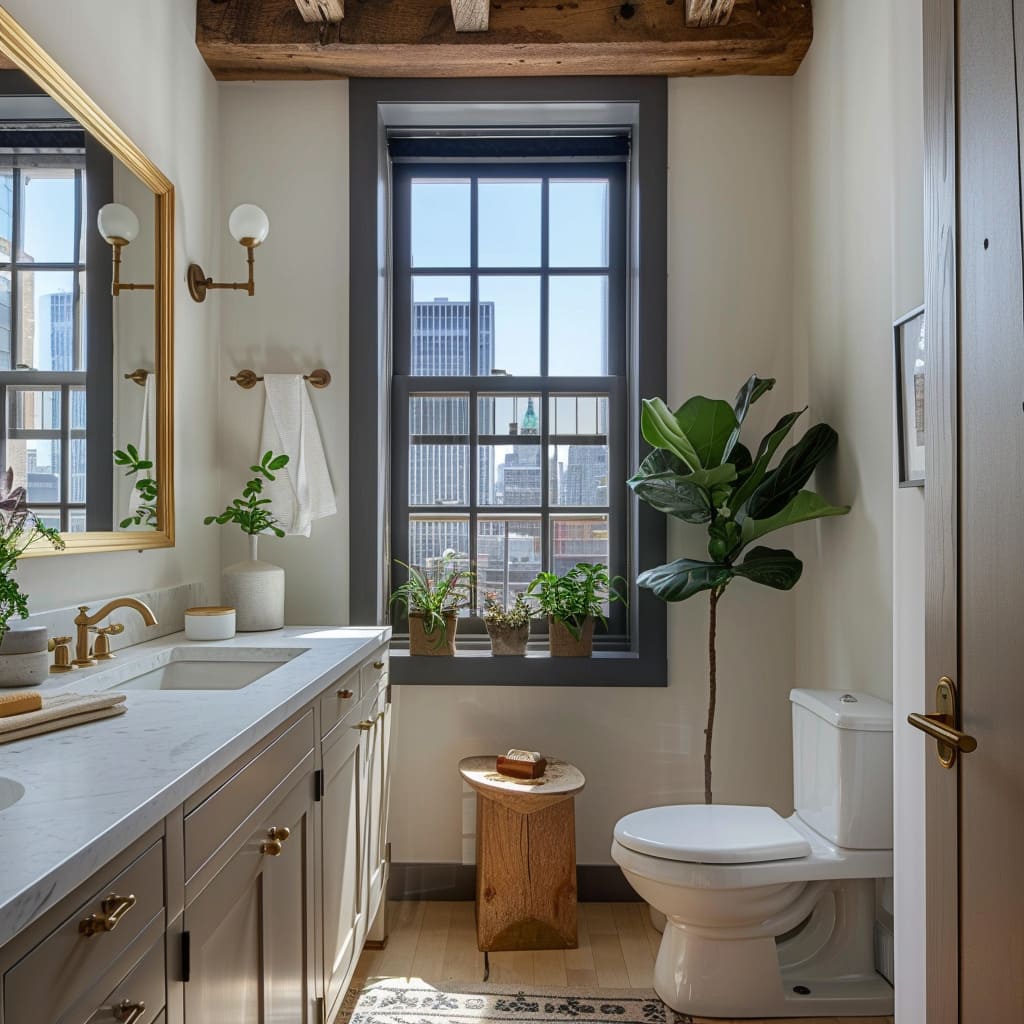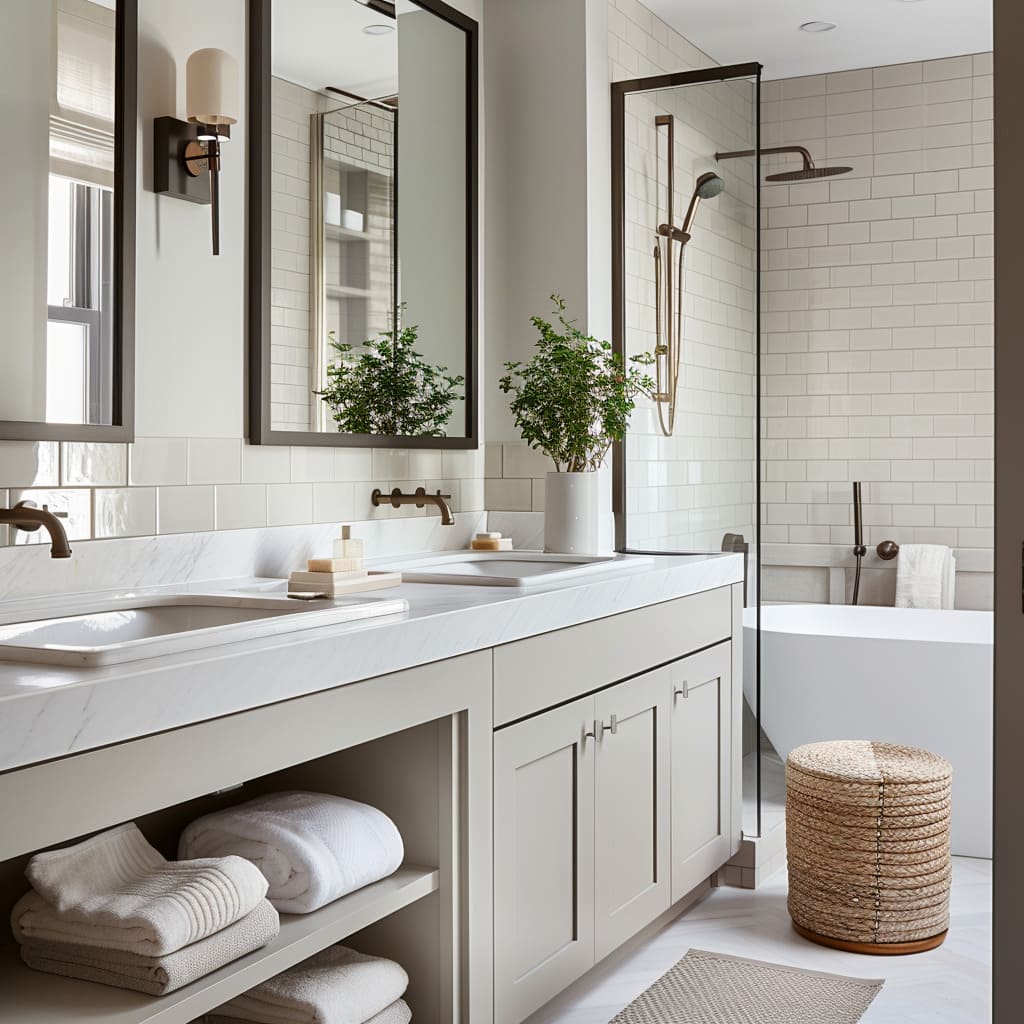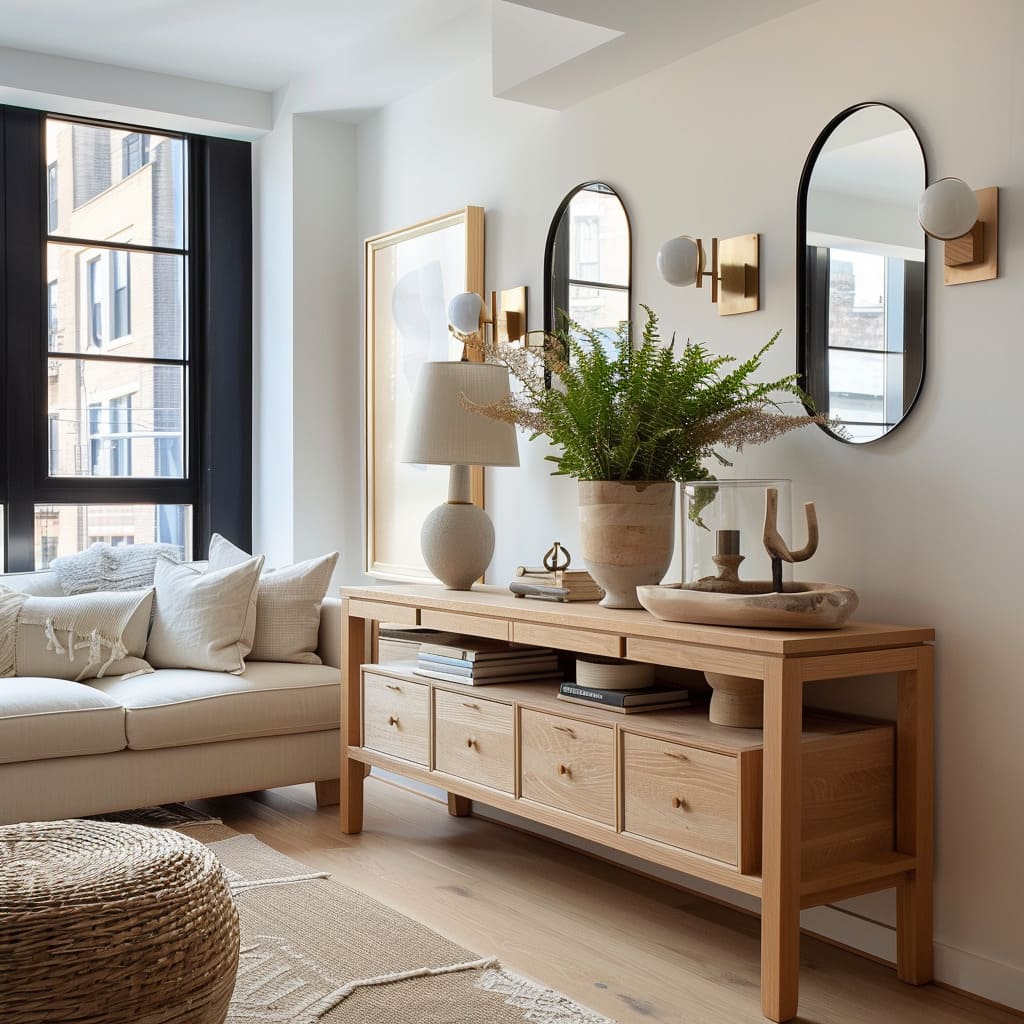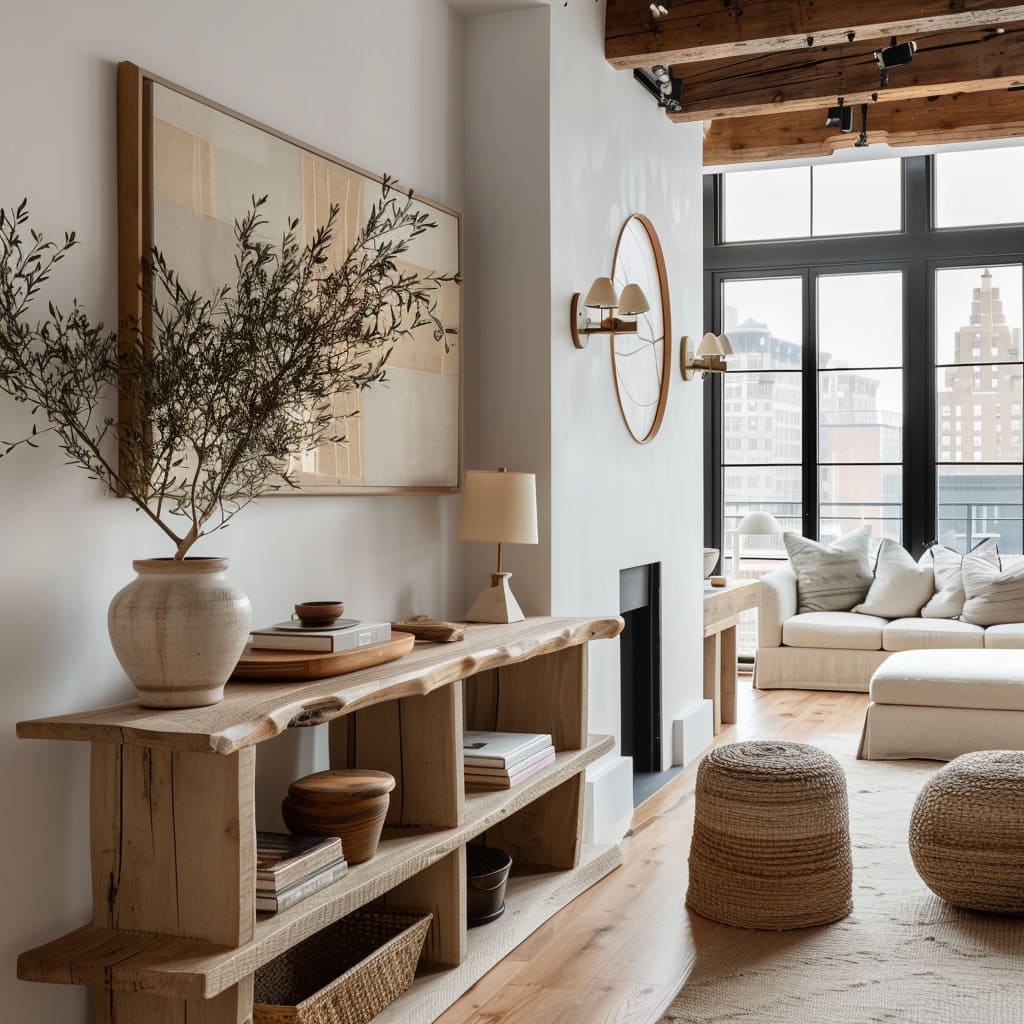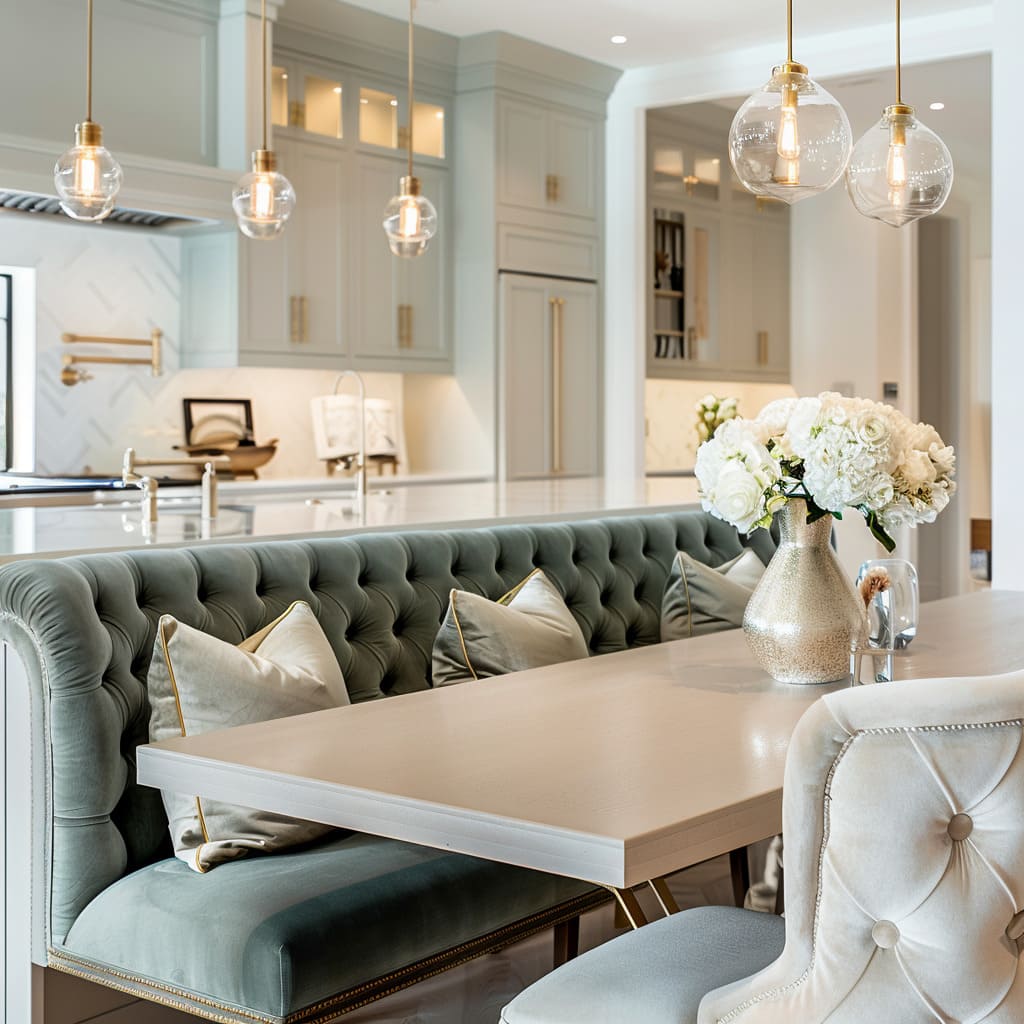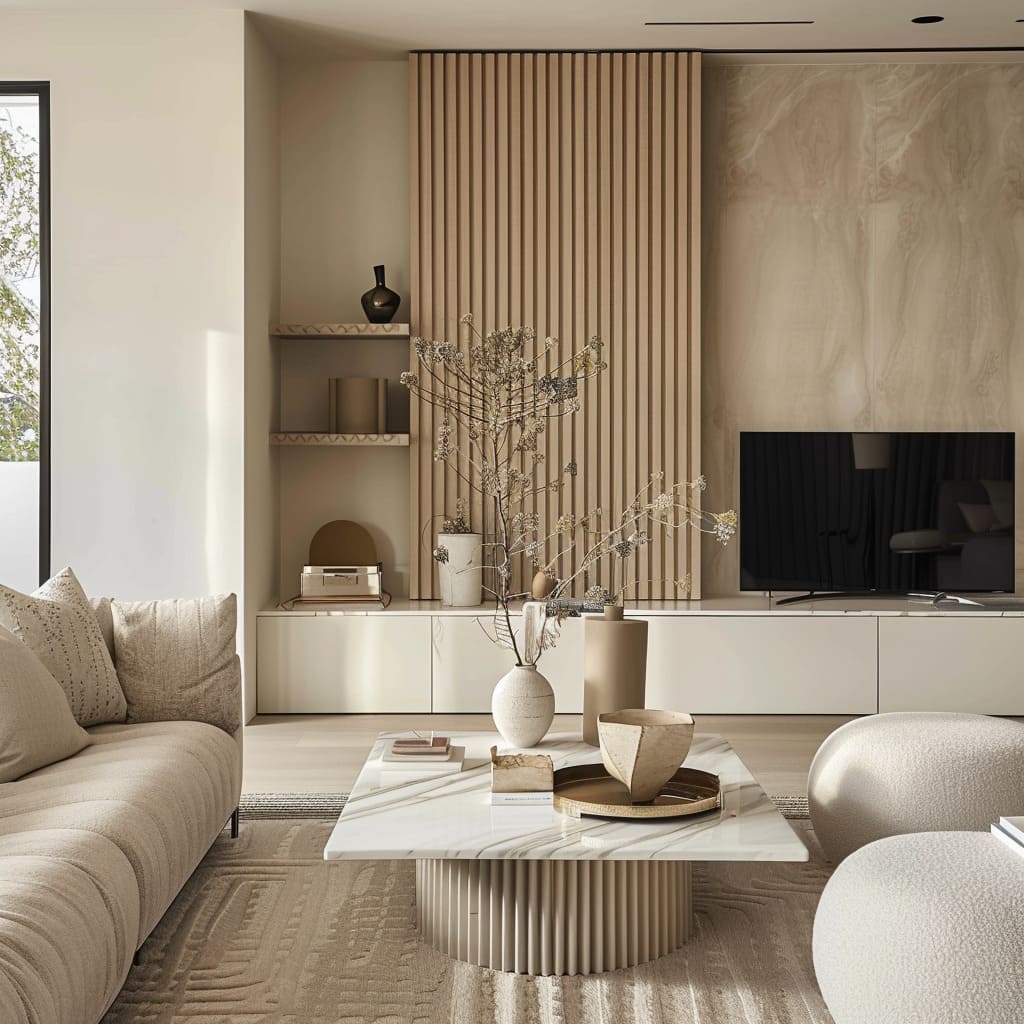Today’s homes are more than just places to live; they are spaces where beauty meets practicality, especially in kitchens and bathrooms. These rooms, essential for daily routines, also reflect personal tastes and design ambitions.
As trends evolve, homeowners and designers alike seek innovative ways to blend visual appeal with usability. This article delves into modern trends that accomplish these goals, providing insights into creating spaces that are both practical and inviting
Optimizing Layouts for Efficiency and Aesthetics
Kitchens
The heart of the home, the kitchen, has transcended its traditional roles to become a centerpiece of social interaction and culinary delight. Efficient designs like the linear layout optimize space in urban homes, while open concepts integrate cooking areas with living spaces, promoting a fluid living experience.
Adding a dining nook or an island with seating encourages gatherings, transforming the kitchen into a communal space where functionality meets comfort
Bathrooms
Modern bathrooms balance spatial dynamics through thoughtful layouts that separate wet and dry areas, enhancing comfort and practicality. Designers often incorporate luxurious elements like freestanding tubs, even in limited spaces, to offer spa-like experiences.
These strategic layouts not only maximize physical space but also cater to the aesthetic and functional needs of diverse families
How do the choice and placement of lighting fixtures enhance both the functionality and aesthetics of the modern kitchens described, especially in settings where natural light is limited?
In the modern kitchens described, the choice and placement of lighting fixtures are strategically tailored to enhance both functionality and aesthetics, particularly in settings where natural light is limited. Here’s a detailed look at how this is achieved:
Enhancing Functionality
Task Lighting: Kitchens require precise lighting to facilitate safe and efficient food preparation. In areas where natural light is limited, task lighting becomes essential.
Overhead and under-cabinet lights are commonly placed directly over work surfaces like countertops, sinks, and stoves. These lights are designed to be bright enough to illuminate tasks without creating shadows or glare, improving visibility for cutting, cooking, and cleaning
Adjustable and Directed Lighting: Many modern kitchens feature lighting fixtures that can be adjusted in terms of both intensity and direction. For instance, track lighting or pendant lights with adjustable arms allow users to direct light exactly where it’s needed, which is particularly useful in areas that lack sufficient natural light.
This feature ensures that every corner of the kitchen can be well-lit, enhancing the functionality of the space
Enhancing Aesthetics
Ambient Lighting: In addition to its functional role, lighting in a kitchen also plays a key aesthetic role. Ambient lighting, such as soft overhead lights or wall-mounted fixtures, provides a warm, inviting glow that makes the kitchen a welcoming space for family and friends.
This type of lighting is used to create an atmosphere rather than for practical tasks, and it can dramatically transform the look and feel of a kitchen, especially in the evenings or on cloudy days when natural light is scarce
Accent Lighting: Modern kitchens often use accent lighting to highlight architectural features, artwork, or beautiful cabinetry. This might include in-cabinet lighting, toe-kick lights, or spotlighting used to draw attention to a particular element.
Such lighting not only adds a layer of sophistication but also contributes to the overall design by creating visual interest and depth
Cohesive Design Elements: The style and design of the light fixtures themselves also contribute to the kitchen’s aesthetic appeal. Designers might choose fixtures that complement the kitchen’s overall design theme—be it minimalist, rustic, or industrial.
The materials, finishes, and colors of the lighting fixtures can harmonize with other elements in the kitchen, such as the hardware on the cabinets or the color scheme, tying the entire space together in a visually appealing manner
Overall Impact
The strategic placement and careful selection of lighting in kitchens where natural light is limited not only ensure that the space is functional and easy to navigate but also create a visually appealing environment that enhances the user’s experience. By combining various types of lighting at different levels and zones, the kitchen becomes a multifunctional space that is both practical for cooking and pleasant for socializing, regardless of the natural light available.
In what ways do the materials and finishes selected for bathroom surfaces contribute to the ease of maintenance and longevity of the space, particularly in bathrooms that combine both rustic and contemporary design elements?
In bathrooms that artfully blend rustic and contemporary design elements, the selection of materials and finishes plays a crucial role in ensuring both ease of maintenance and longevity. Here’s an in-depth look at how these materials contribute to the overall durability and functionality of such spaces:
Durability and Ease of Maintenance
Tile Selection: Bathrooms typically use materials that can withstand high moisture levels. Ceramic and porcelain tiles are popular choices due to their water-resistant properties and ease of cleaning.
For a rustic yet contemporary look, large format tiles with minimal grout lines reduce the buildup of mold and mildew, which are common in bathroom environments. The larger tiles also lend a more modern aesthetic while the texture and color choices can enhance the rustic feel
Surface Finishes: Matte finishes are often selected for rustic-contemporary bathrooms as they are less prone to show water spots and fingerprints than glossy surfaces. This makes them easier to maintain on a day-to-day basis.
Matte finishes also contribute to the rustic aesthetic, providing a soft, understated look that complements natural wood or stone elements often used in this style
Countertop Materials: Quartz is a favored choice for bathroom countertops in modern rustic designs because of its durability and low maintenance. Unlike natural stone, which might require regular sealing, quartz is non-porous, resisting staining and not requiring frequent upkeep.
Its sleek, contemporary look can be adapted to match rustic elements through color and finish options.
Longevity
Quality Fixtures: In bathrooms, investing in high-quality fixtures such as faucets, showerheads, and cabinet hardware made from durable materials like stainless steel or brass can significantly enhance longevity.
These materials are not only resistant to corrosion and tarnishing but also fit well within both rustic and contemporary aesthetics. Choosing fixtures with a timeless design ensures they remain stylistically relevant and functionally efficient for years
Sealants and Protective Coatings: Applying sealants on natural materials like wood or stone is crucial in rustic-themed bathrooms to prevent water damage and wear over time. Protective coatings on metals and painted surfaces can also prevent peeling and rust, which contributes to both the functionality and appearance of the space.
Integrated Sustainability: Beyond just the material durability, the design might include elements that promote sustainability, like low-flow faucets and toilets, LED lighting, and energy-efficient windows. These features not only improve the longevity of the bathroom’s design by reducing the need for future upgrades but also align with contemporary trends towards eco-friendly living solutions
Aesthetic Harmony
Combining Textures and Colors: The choice of materials also plays a significant role in creating aesthetic harmony between rustic and contemporary elements. For example, a wooden vanity with visible grain can offer a rustic charm, while smooth, neutral-colored wall tiles can lean towards a sleek, modern look.
Balancing these textures and colors can make the bathroom feel cohesive and thoughtfully designed
Custom Elements: Custom-made fixtures or unique handcrafted tiles can be used to bridge the gap between old-world rustic charm and clean, modern lines. These elements not only enhance the bathroom’s design but also ensure it is uniquely tailored to the homeowner’s taste, increasing the overall satisfaction and enjoyment of the space
By carefully selecting materials and finishes that align with both rustic and contemporary themes, designers can create bathrooms that are not only visually appealing but also practical and durable. This thoughtful integration ensures the spaces are well-equipped to withstand the rigors of daily use while maintaining their aesthetic appeal over time
Materials and Finishes That Define Modern Spaces
Kitchens
Natural wood finishes in kitchens, such as oak or maple, introduce warmth and character, setting a welcoming tone. These materials are not only chosen for their beauty but also for their durability and ease of maintenance.
Lighter wood tones keep the space feeling open and bright. In contrast, countertops in quartz or marble offer longevity and stain resistance, important for kitchen tasks, while adding a touch of sophistication
Bathrooms
The choice of tiles and surfaces in bathrooms is critical for creating a desired ambiance while ensuring longevity. Large, light-colored tiles can make a small bathroom feel more spacious and are easier to clean.
Matte finishes on fixtures and subtle color palettes contribute to a calm and relaxing environment, turning the bathroom into a personal retreat
How do the chosen materials for kitchen countertops, such as quartz or marble, impact the overall lighting ambiance of the kitchen, especially in designs where natural light is limited?
The choice of materials for kitchen countertops, particularly reflective surfaces like quartz or marble, plays a significant role in impacting the overall lighting ambiance of the kitchen, especially in spaces where natural light is limited. Here’s a detailed exploration of how these materials enhance the lighting:
Enhancing Natural Light
Reflective Qualities: Quartz and marble have glossy, reflective surfaces that can significantly brighten a kitchen by bouncing light around the room. In areas with limited natural light, these materials can help maximize the available light by reflecting it across the kitchen.
This reflection is particularly effective when the countertops are light in color, such as white or cream, which naturally reflect more light than darker shades
Color and Finish: The color and finish of the countertop material also contribute to the lighting ambiance. Light-colored quartz or marble can enhance the sense of brightness in a kitchen, making the space appear larger and more open.
Even in artificial lighting conditions, light-colored countertops can help to amplify the effect of light fixtures, reducing the need for additional lighting sources and contributing to a more energy-efficient kitchen design
Impact on Artificial Lighting
Uniform Light Distribution: The reflective surfaces of quartz and marble countertops can help distribute artificial light more evenly throughout the kitchen. This uniform distribution helps eliminate shadows and dark corners, making the kitchen more functional for tasks that require good visibility, such as cooking and meal preparation
Accentuating Lighting Fixtures: Countertops made from reflective materials like quartz and marble can also accentuate the effects of under-cabinet lighting. This lighting, when reflected off glossy countertops, creates a luminous effect that enhances both the functionality and aesthetic appeal of the kitchen.
This is particularly beneficial in kitchens where ambient lighting is subdued or where dramatic lighting effects are desired
Aesthetic and Functional Synergy
Synergy with Other Materials: Reflective countertops can complement other kitchen materials, such as glass or metal, creating a cohesive look that enhances the overall aesthetic of the space. This synergy can contribute to a brighter and more inviting kitchen ambiance, which is crucial in designs where natural light is scarce
Mood Enhancement: The bright and airy feel that reflective countertops lend to a kitchen can also influence mood. Brighter spaces are often associated with positivity and can make a kitchen feel more welcoming and comfortable to spend time in.
This psychological aspect is essential in homes where the kitchen serves as a central hub for family activities and social gatherings
In summary, the use of quartz or marble countertops in kitchen designs not only enhances the aesthetic value of the space but also plays a critical role in optimizing both natural and artificial lighting. This optimization is particularly impactful in kitchens with limited access to natural light, where these materials can transform the lighting ambiance, making the space feel brighter, larger, and more inviting.
In what ways do wooden accents in the bathroom, such as vanity cabinets or shelving, influence the acoustics of the space, considering bathrooms typically have harder surfaces that can echo sound?
Wooden accents in the bathroom, such as vanity cabinets or shelving, can significantly influence the acoustics of the space, especially in environments where harder surfaces can create echoes. Here’s a closer look at how wood impacts bathroom acoustics:
Sound Absorption
Natural Absorber: Wood is inherently less reflective than materials like tile, glass, or metal, commonly found in bathrooms. As a porous material, wood can absorb some sound waves instead of reflecting them.
This absorption helps to reduce the echo that is often noticeable in bathrooms with hard, smooth surfaces. By integrating wooden vanities or shelving, the overall sound level in the bathroom can be diminished, creating a more muted and pleasant acoustic environment
Surface Irregularities: The natural grain and texture of wood contribute to its ability to scatter sound waves. Unlike flat, hard surfaces that can bounce sound waves in a uniform direction, the slight irregularities in wood surfaces disrupt sound waves, reducing reverberation.
This scattering effect helps to further soften sounds in the bathroom, such as the running water or the hum of appliances, leading to a more comfortable auditory experience
Acoustic Warmth
Warmth and Resonance: Wood not only improves the sound quality by reducing echoes but also adds a warm, resonant quality to sounds. This is why wood is a preferred material in musical instruments and interior design.
In a bathroom, wooden elements can make the space feel more inviting and less sterile, enhancing the sounds that are present, such as soft music or the voice of a person speaking, making them more pleasing to the ear
Combination with Other Materials: When combined with other materials in the bathroom, such as stone or tile, wood can help balance the acoustic properties of the space. For instance, if a bathroom has stone countertops and tiled floors, adding a wooden vanity or wooden frames around mirrors can counteract the echo effects these hard surfaces might produce.
Overall Impact on Bathroom Design
Design Flexibility: Wooden accents offer design flexibility that contributes not just to the visual appeal but also to the acoustic comfort. Designers can use different types of wood with various finishes to match the bathroom’s aesthetic while improving the sound quality.
Lighter woods like pine or bamboo are excellent for a brighter, airy feel, whereas darker woods like walnut add richness and depth to the space
Enhanced Privacy: In bathrooms, privacy is crucial. Improved acoustics due to wooden elements can make conversations less audible to those outside the bathroom and reduce the travel of sounds from adjacent rooms or floors.
This acoustic isolation helps to enhance the sense of privacy and seclusion in the bathroom, which is especially important in shared or family homes
By incorporating wooden accents into the bathroom design, homeowners and designers can significantly enhance the acoustic quality of the space. This not only makes the bathroom more functional and comfortable but also elevates the overall sensory experience, creating a sanctuary where both the visual and auditory elements are in harmony.
What role do the textures and colors of the natural wood finishes in kitchens play in influencing the perceived temperature of the space?
The textures and colors of natural wood finishes in kitchens play a significant role in influencing the perceived temperature of the space. This effect is both psychological and sensory, impacting how comfortable and welcoming the kitchen feels.
Here’s a detailed examination of how these elements of wood contribute to the perception of temperature:
Psychological Influence of Color
Warmth Perception: Wood naturally exudes a warm appearance due to its colors and grain patterns. Shades of brown, tan, and cream in wood finishes can make a space feel warmer.
In kitchens, where comfort and coziness are prized, the warm tones of wood can make the space seem more inviting and snug, particularly in cooler climates or seasons. Color Depth and Variety: The depth of color in wood finishes also affects how temperature is perceived.
Darker woods absorb more light, which can make a space feel warmer, while lighter woods reflect light, contributing to a cooler feel. However, even lighter woods maintain a warmth due to their natural hues and textures, balancing light reflection with warm undertones
Textural Impact on Temperature Perception
Smooth vs. Rough Textures: The texture of the wood finish can influence how the temperature is perceived.
Smooth, polished wood surfaces reflect light differently than rough, untreated woods. Smooth surfaces in lighter finishes can make a space feel cooler, while rough textures, which scatter light more diffusely, enhance the feeling of warmth
Tactile Experience: The tactile experience of wood also affects temperature perception. Wood is naturally warmer to the touch compared to materials like metal or stone, which can feel cold.
This warmth is comforting in a kitchen setting, where physical contact with surfaces happens frequently.
Interplay with Other Elements
Interaction with Light: Natural wood finishes interact dynamically with both natural and artificial light.
In spaces with ample sunlight, wood can absorb and reflect this warmth, enhancing the overall warmth of the space. Under artificial lighting, the glow from wooden surfaces can create a warm ambiance that compensates for the lack of natural light, particularly during evenings
Combination with Other Materials: When combined with other materials in the kitchen, such as metal appliances or stone countertops, wood balances the cooler tones of these materials. This balance helps to regulate the perceived temperature, ensuring the kitchen feels neither too cold due to stone and metal nor excessively warm, maintaining a comfortable median.
Overall Environmental Impact
Enhanced Comfort: Beyond aesthetics, the strategic use of wood in kitchen design can enhance overall environmental comfort. Wood’s natural insulating properties can help maintain room temperature, making the kitchen more energy-efficient and comfortable to spend time in
Emotional and Physical Comfort: The warmth of wood not only influences physical temperature perceptions but also impacts emotional comfort. Kitchens are central hubs of homes, and the warmth imparted by wood can make these spaces more inviting, encouraging family gatherings and social interactions.
In summary, the textures and colors of natural wood finishes significantly influence the perceived temperature of a kitchen, making these spaces feel warmer and more inviting. This effect enhances both the aesthetic appeal and the functional comfort of the kitchen, making wood a popular choice in kitchen design for its beauty and its sensory benefits
Fixtures and Appliances – The Marriage of Form and Function
Kitchens
The right fixtures can transform a kitchen from standard to standout. Sleek, minimalist faucets in stainless steel or matte black finish are popular for their ease of use and modern look, complementing the clean lines of contemporary cabinetry.
Energy-efficient appliances, integrated into cabinetry or as stand-alone pieces, reflect current demands for sustainable living solutions
Bathrooms
In bathrooms, the functionality of fixtures is paramount. Rainfall showerheads offer an immersive showering experience, while streamlined sinks and cabinets in floating designs enhance the sense of space and cleanliness.
Smart bathroom technologies, such as motion-sensing faucets and temperature-controlled environments, combine high-tech convenience with luxury
Innovative Storage Solutions
Kitchens
Storage solutions in modern kitchens strike a balance between hiding clutter and displaying beautiful kitchenware. Innovations like magic corners and pull-out cabinets utilize every inch of space efficiently, making the most of small urban kitchens.
Open shelving, on the other hand, allows for easy access and the display of decorative objects, adding personality to the kitchen without sacrificing functionality
Bathrooms
Efficient storage options are equally important in the bathroom. Vanities with integrated storage systems and stackable drawers help maintain a tidy environment.
Overhead cabinets or custom shelving can also provide additional storage without compromising floor space, crucial in less spacious designs
Decorative Elements and Accessories
Kitchens
A kitchen’s decor should reflect the personal style of the homeowner. Integrating decorative pieces like unique vases, artwork, or custom hardware can add a personal touch that complements the functional aspects of the kitchen.
Thoughtful placement of greenery or herb gardens can bring life to the space, marrying nature with urban living
Bathrooms
Accessories in bathrooms, such as plush towels, artisanal soap dispensers, and stylish bath mats, can enhance the comfort and aesthetic of the space. Soft lighting and carefully selected art pieces can turn the bathroom into a gallery of personal style and taste
Conclusion
The intersection of functionality and style forms the foundation of modern kitchen and bathroom design. As we look to the future, these spaces will continue to evolve, reflecting broader lifestyle trends and technological advancements.
Homeowners looking to renovate or update their spaces should consider these trends to enhance both the utility and beauty of their homes.
